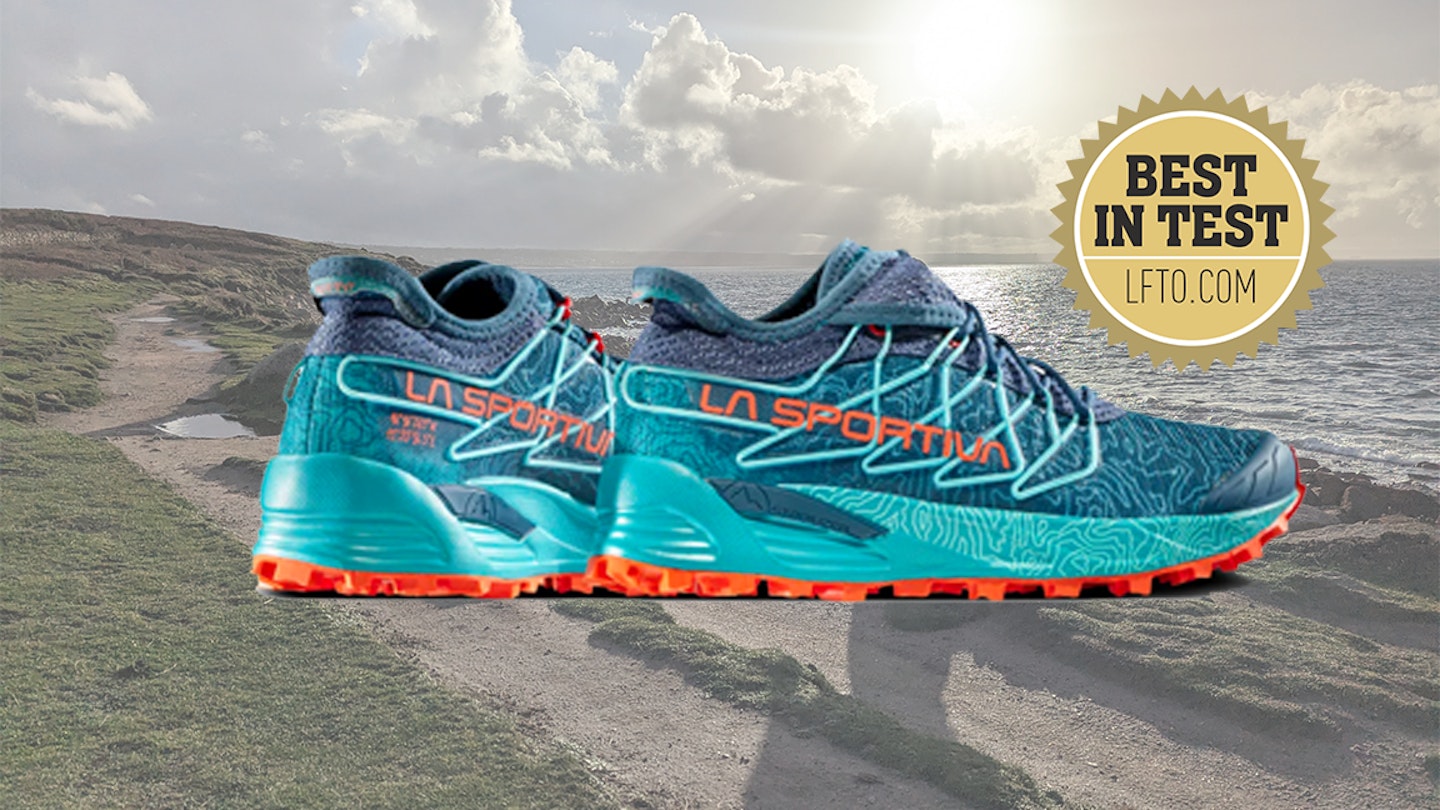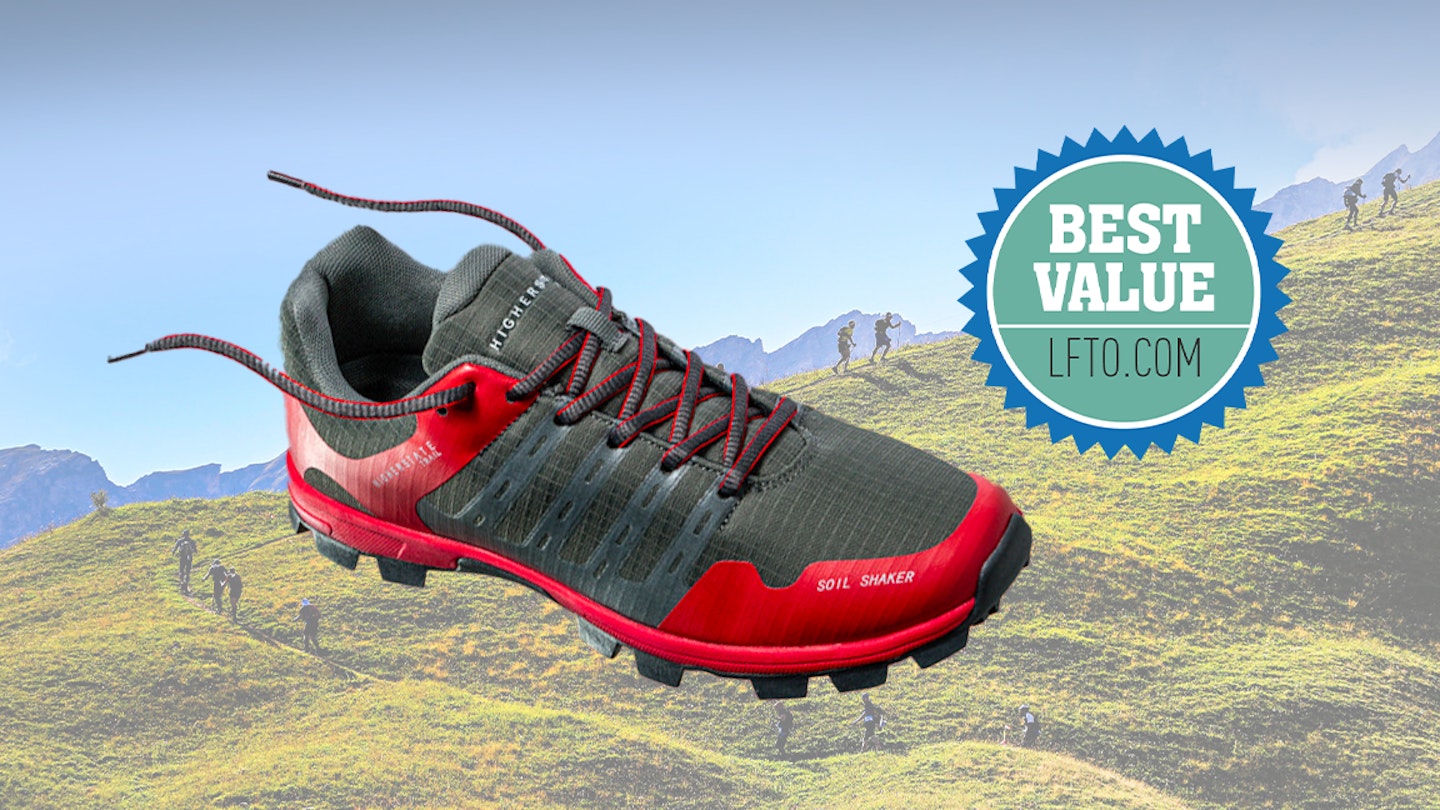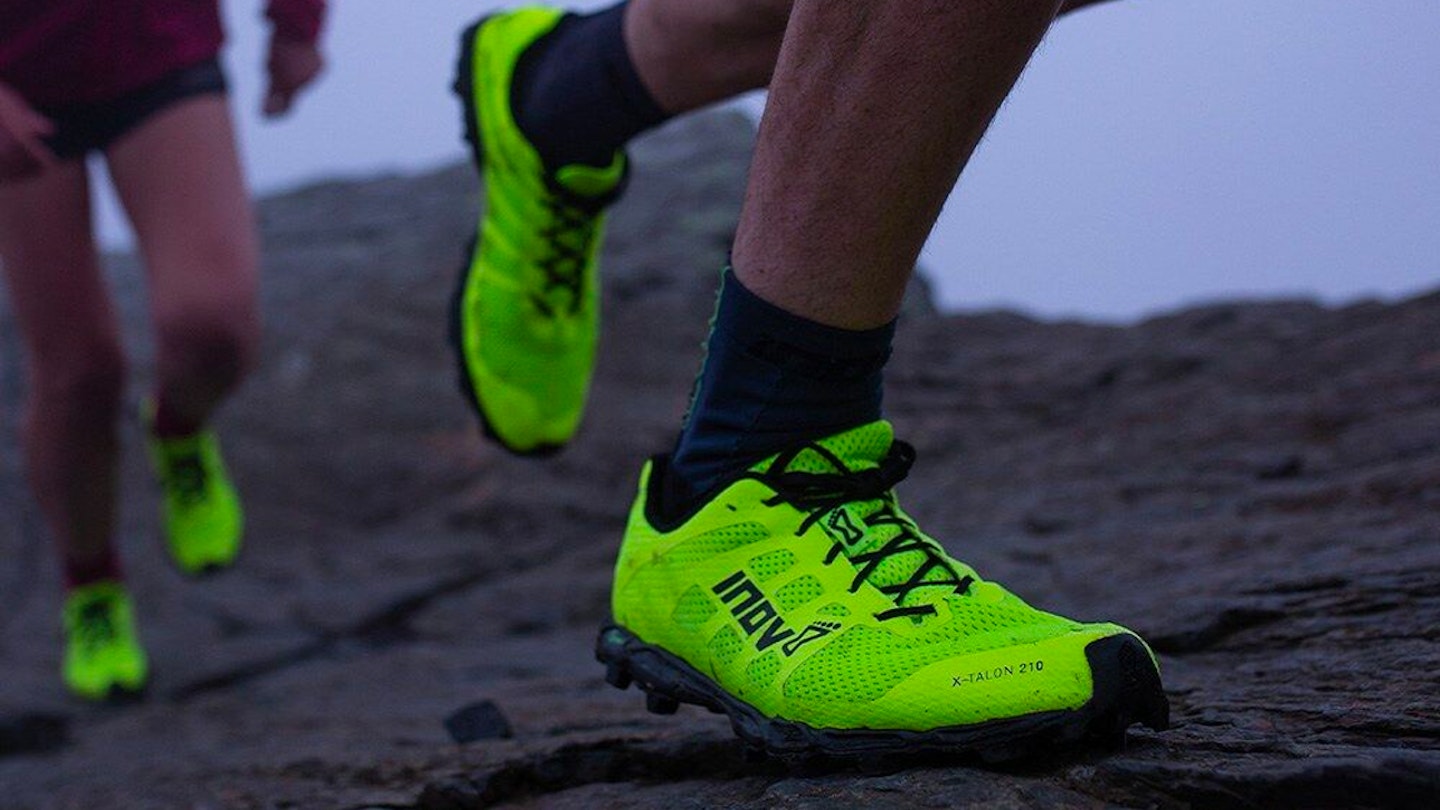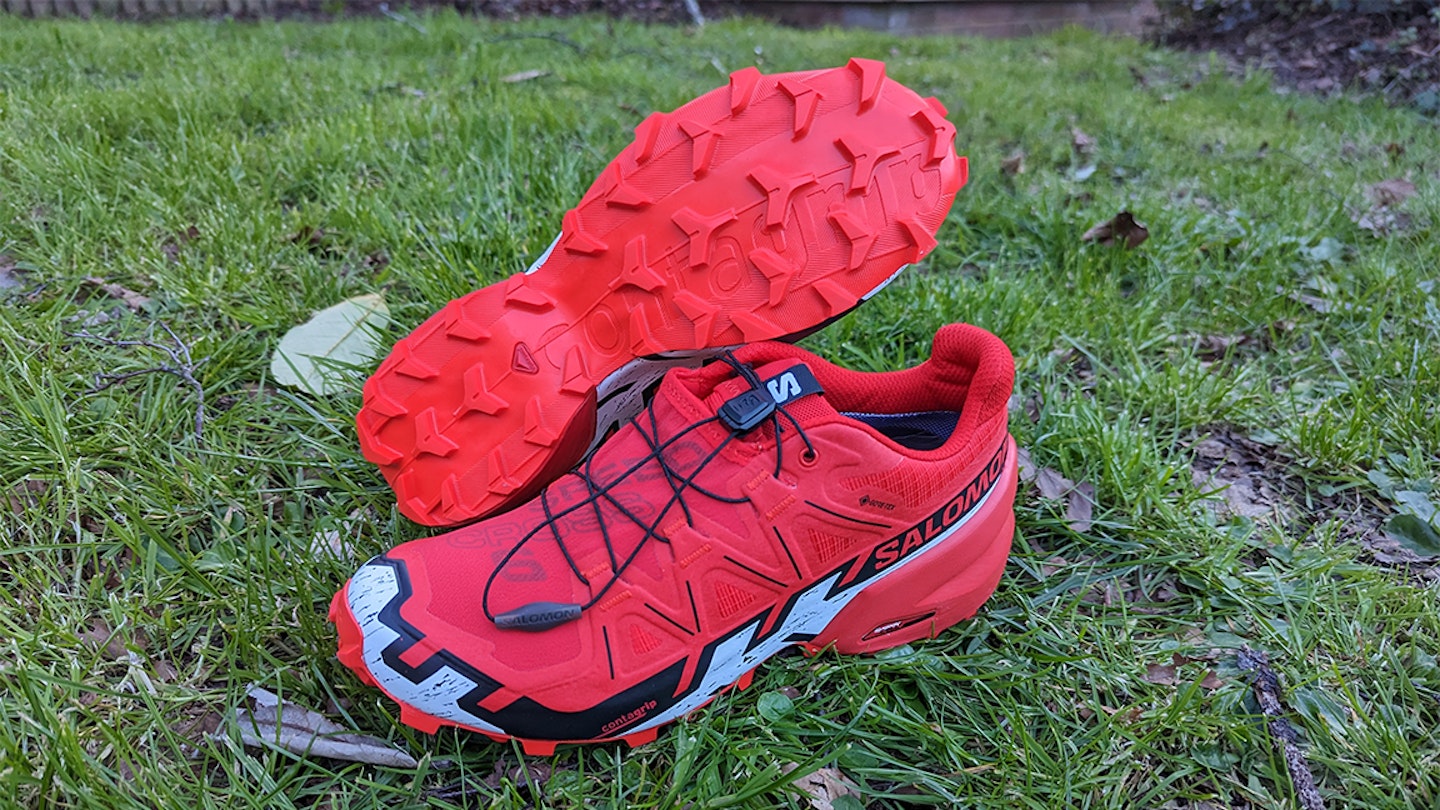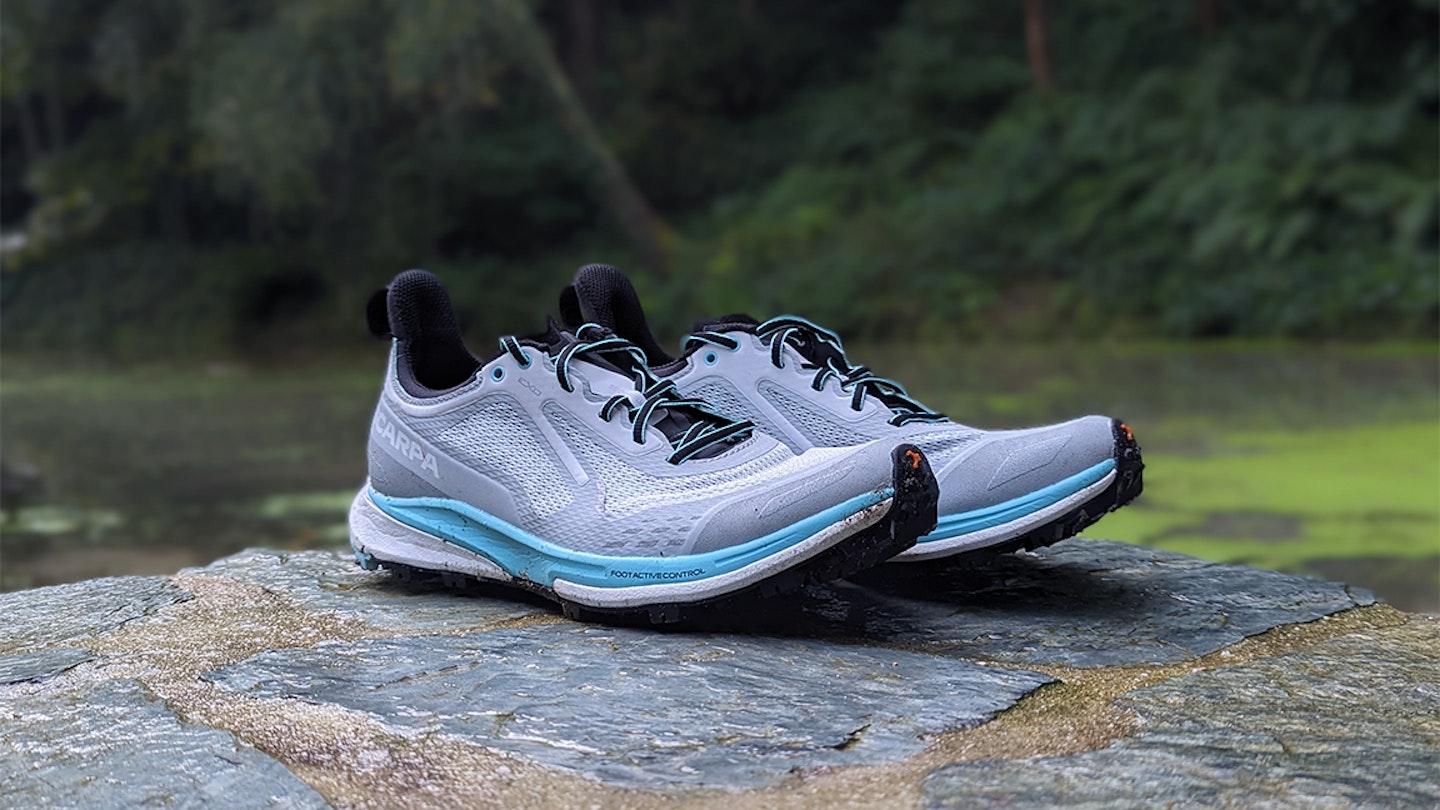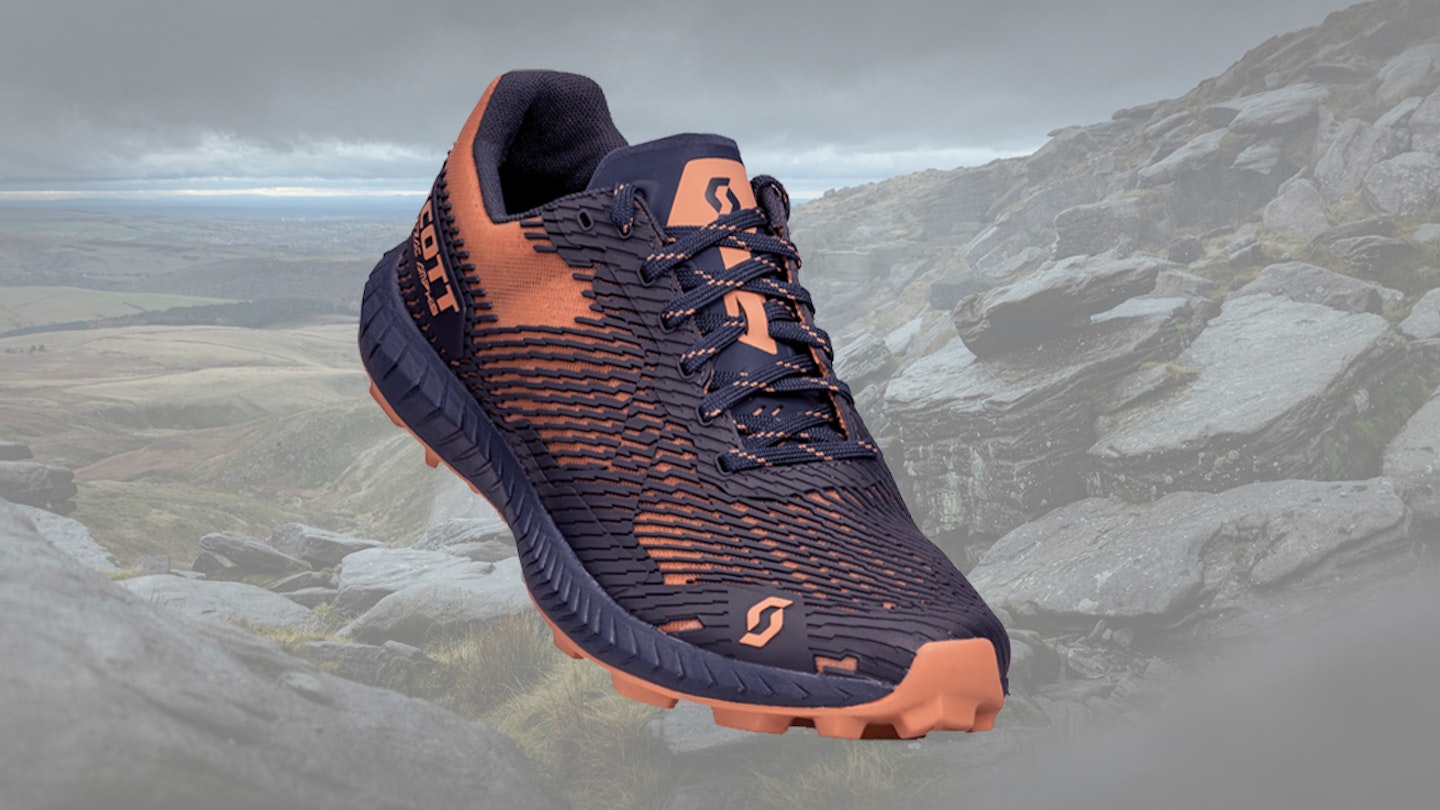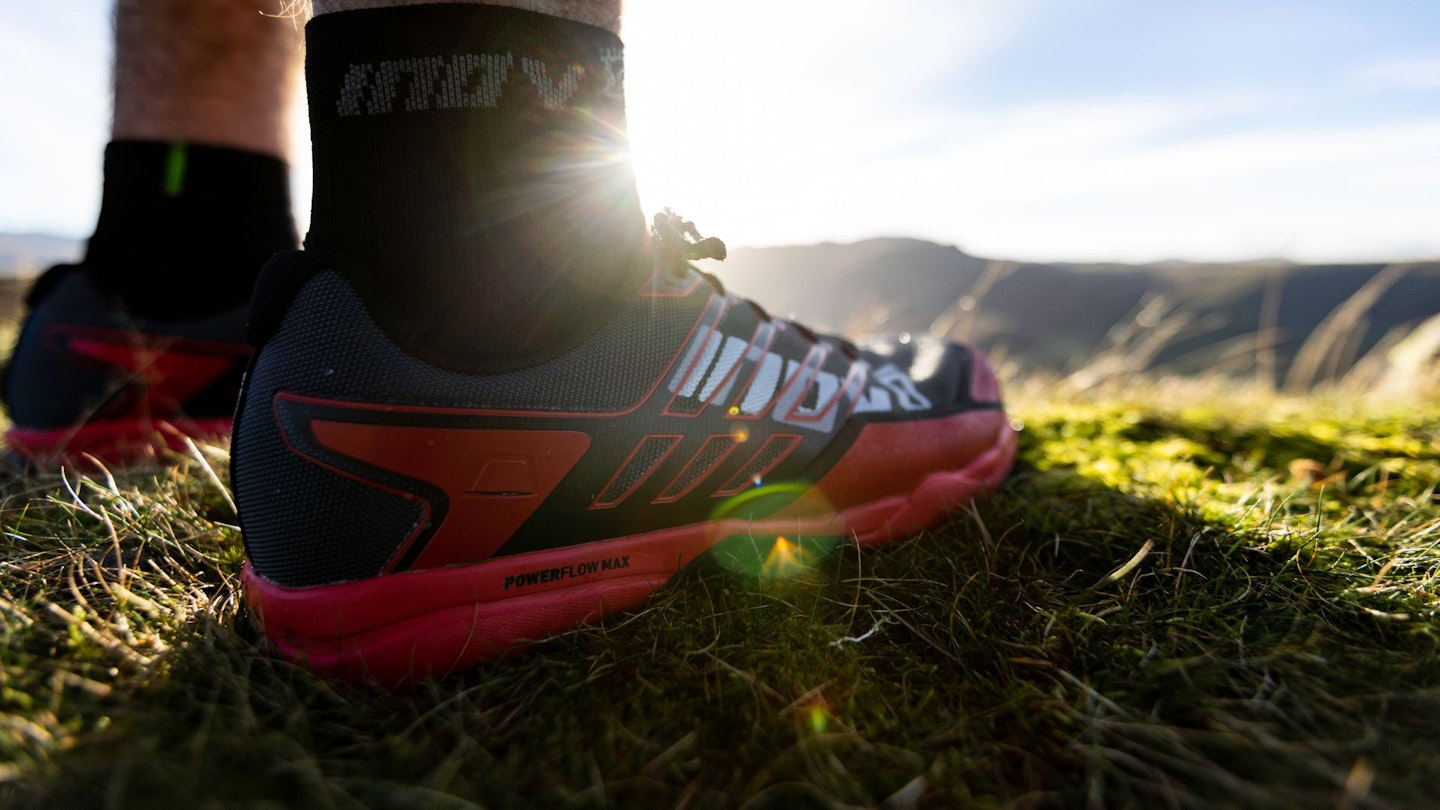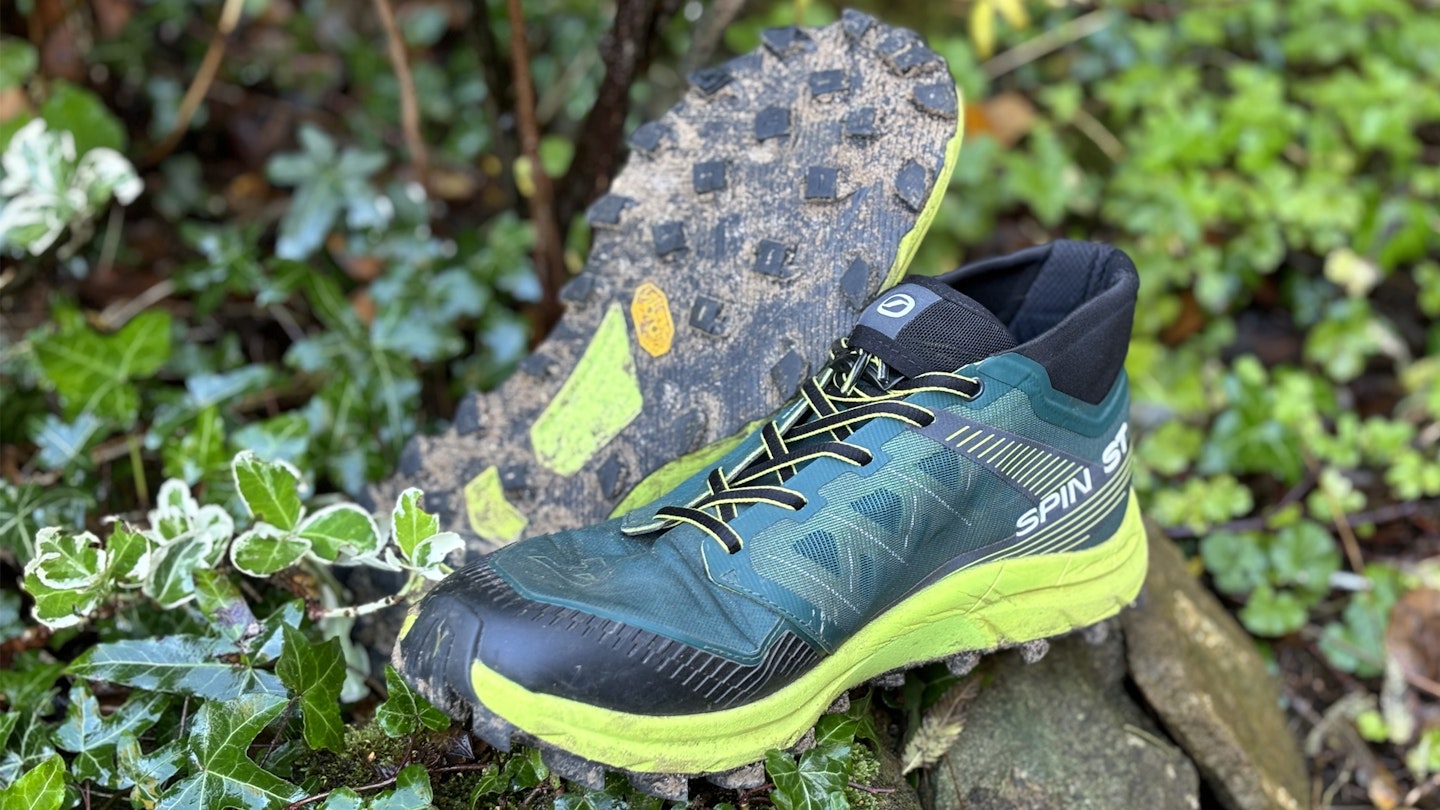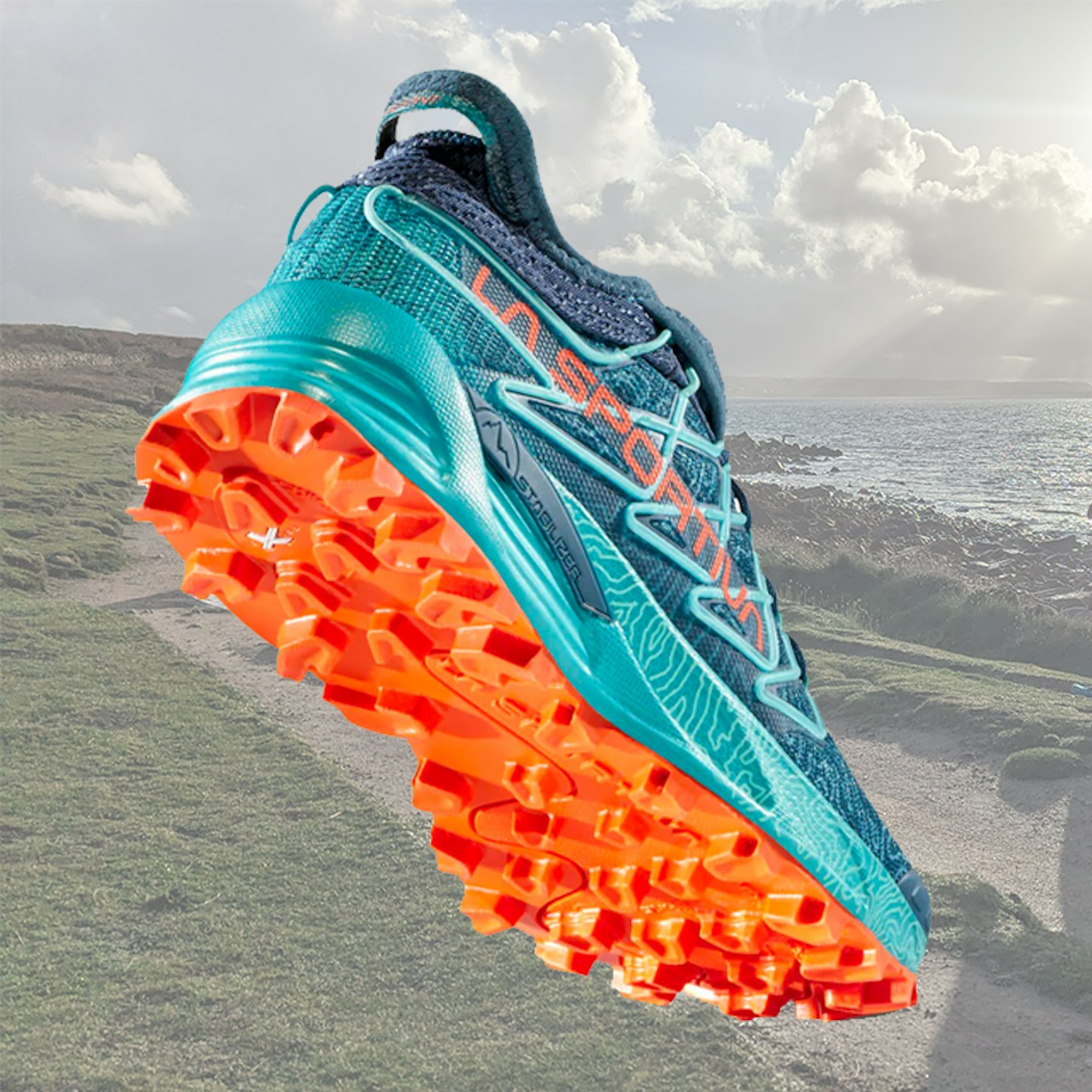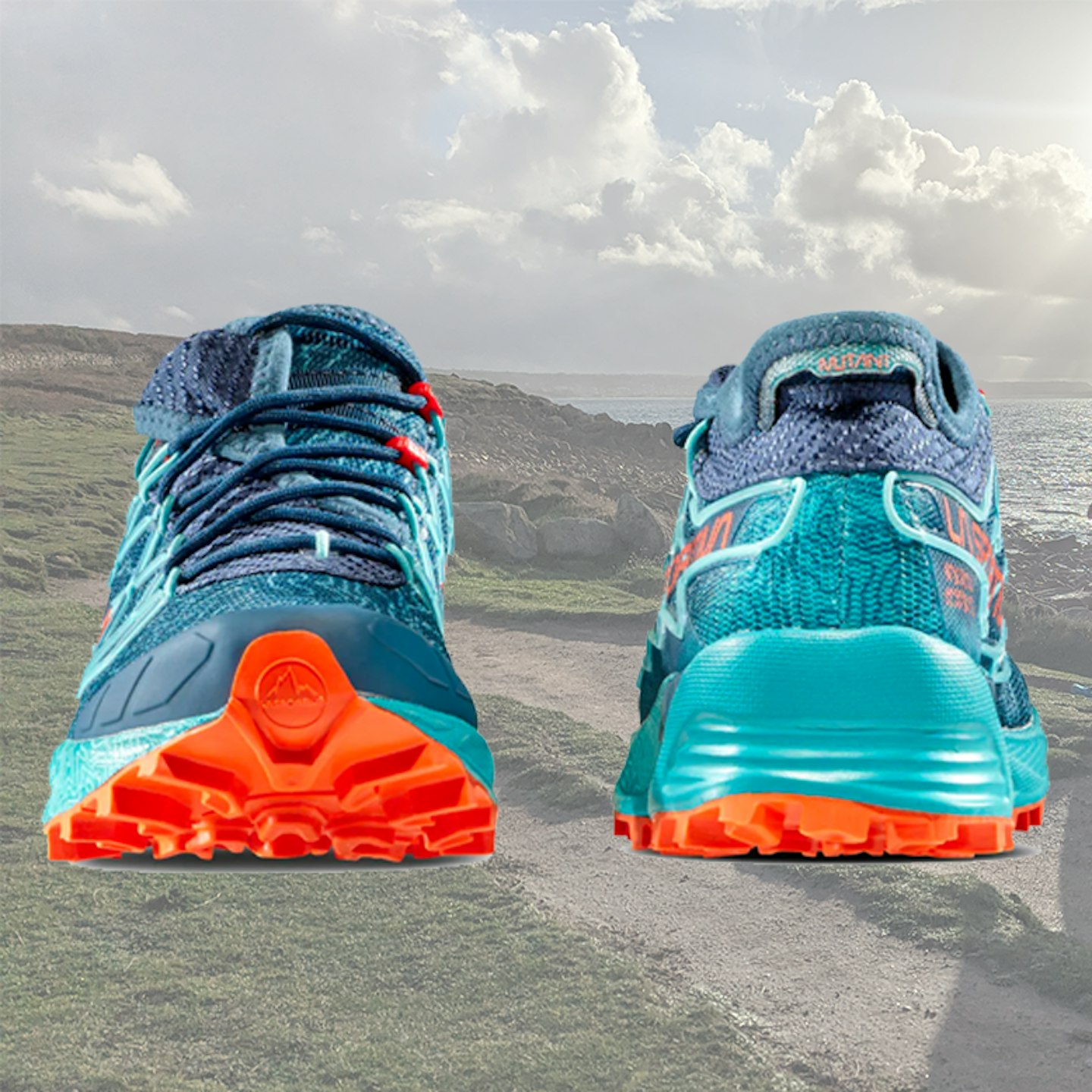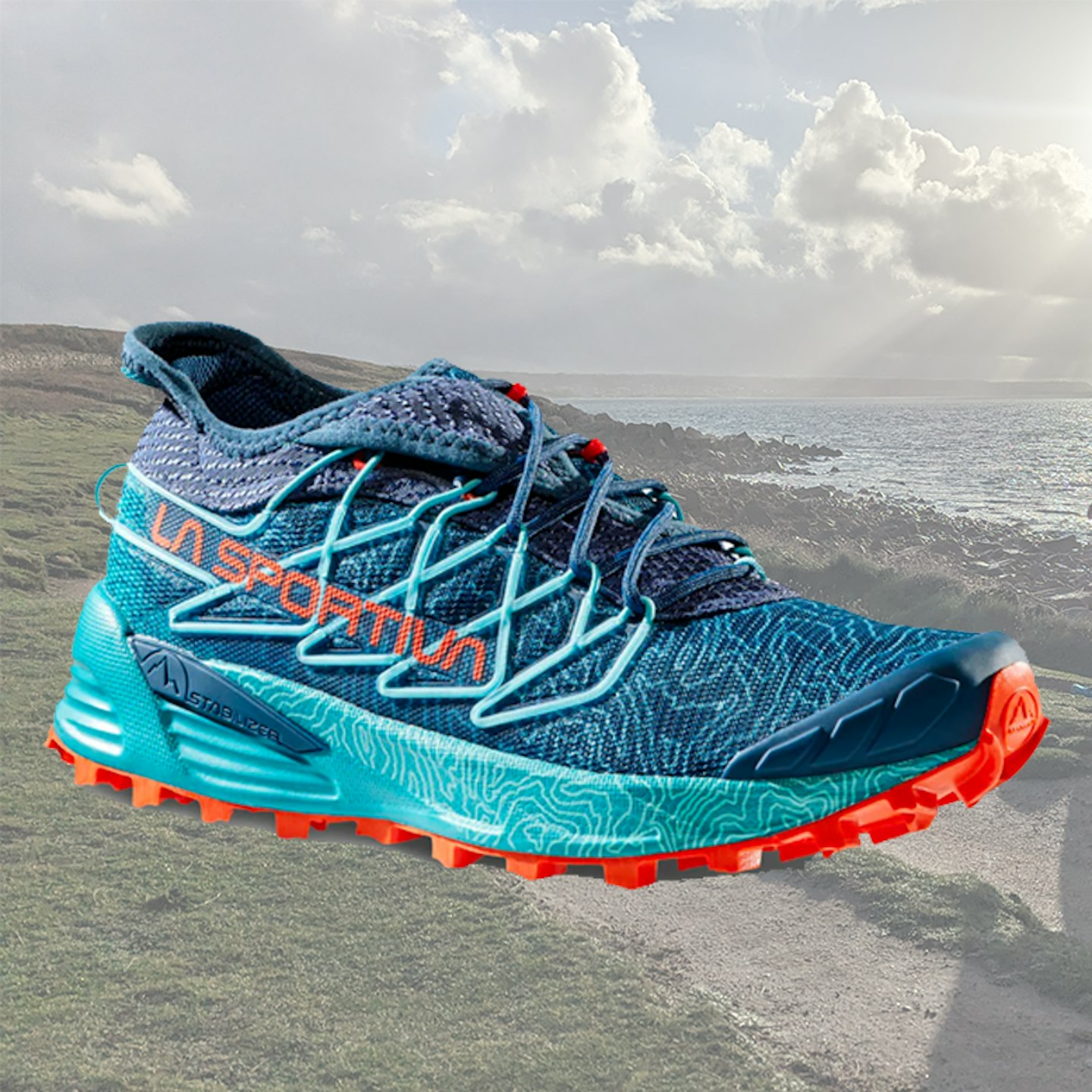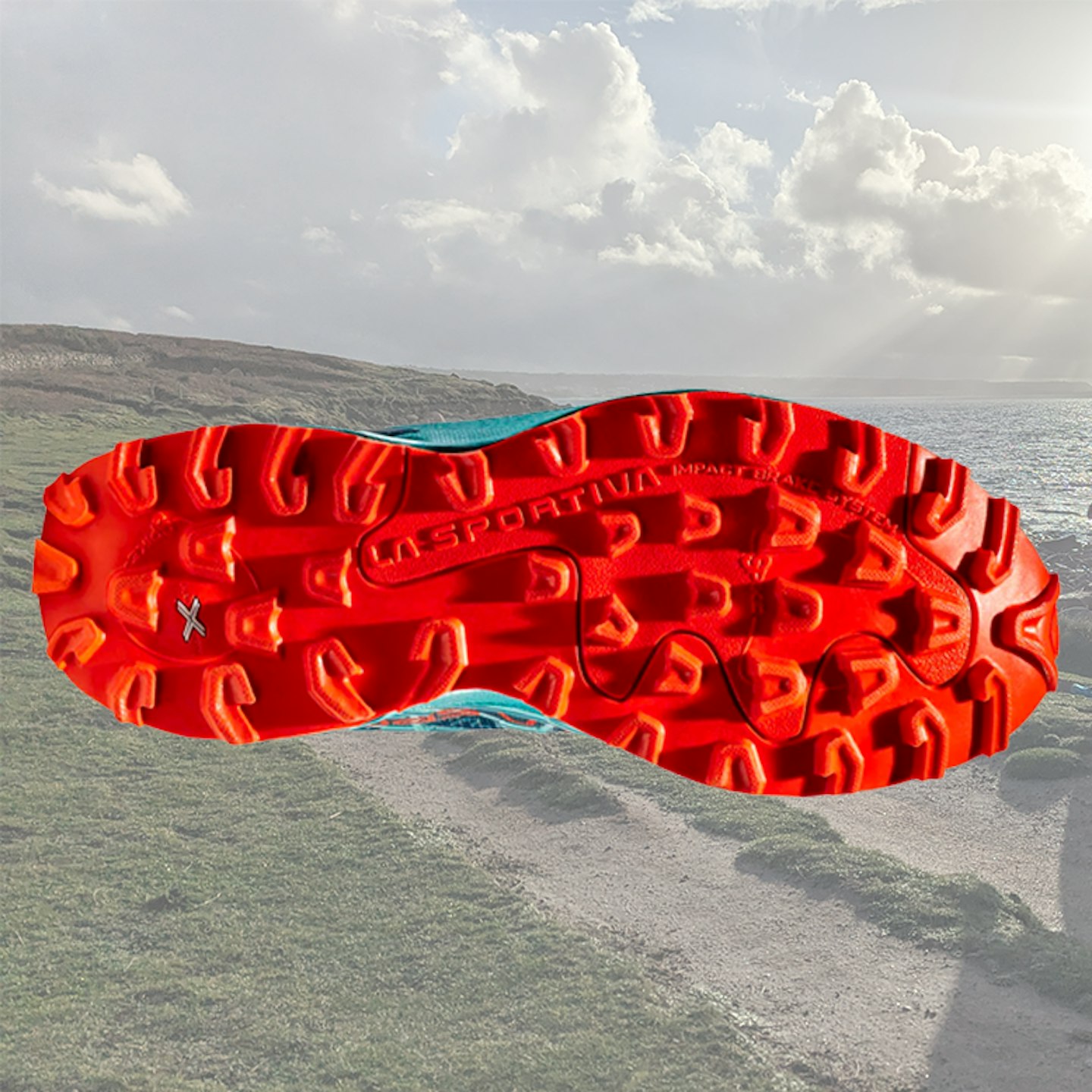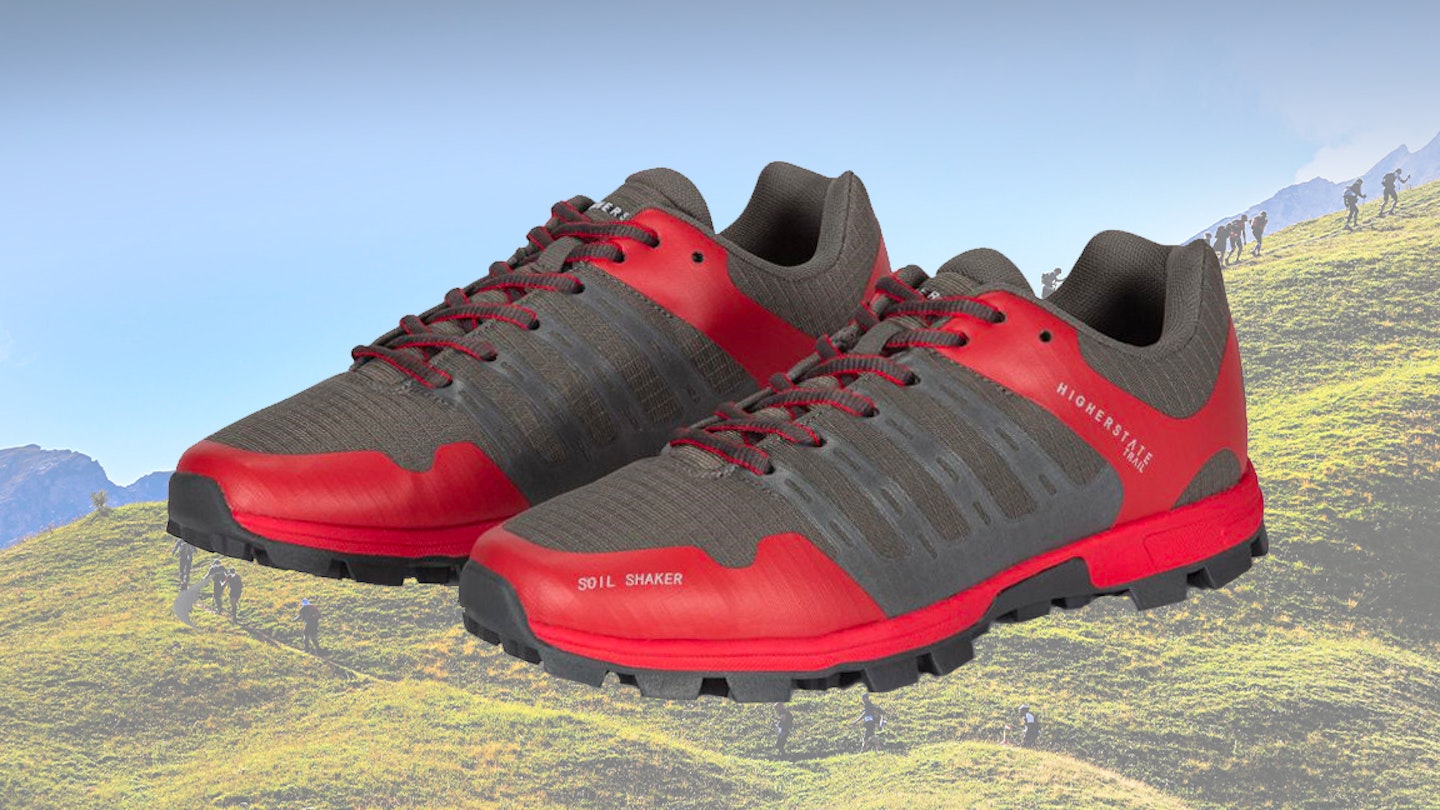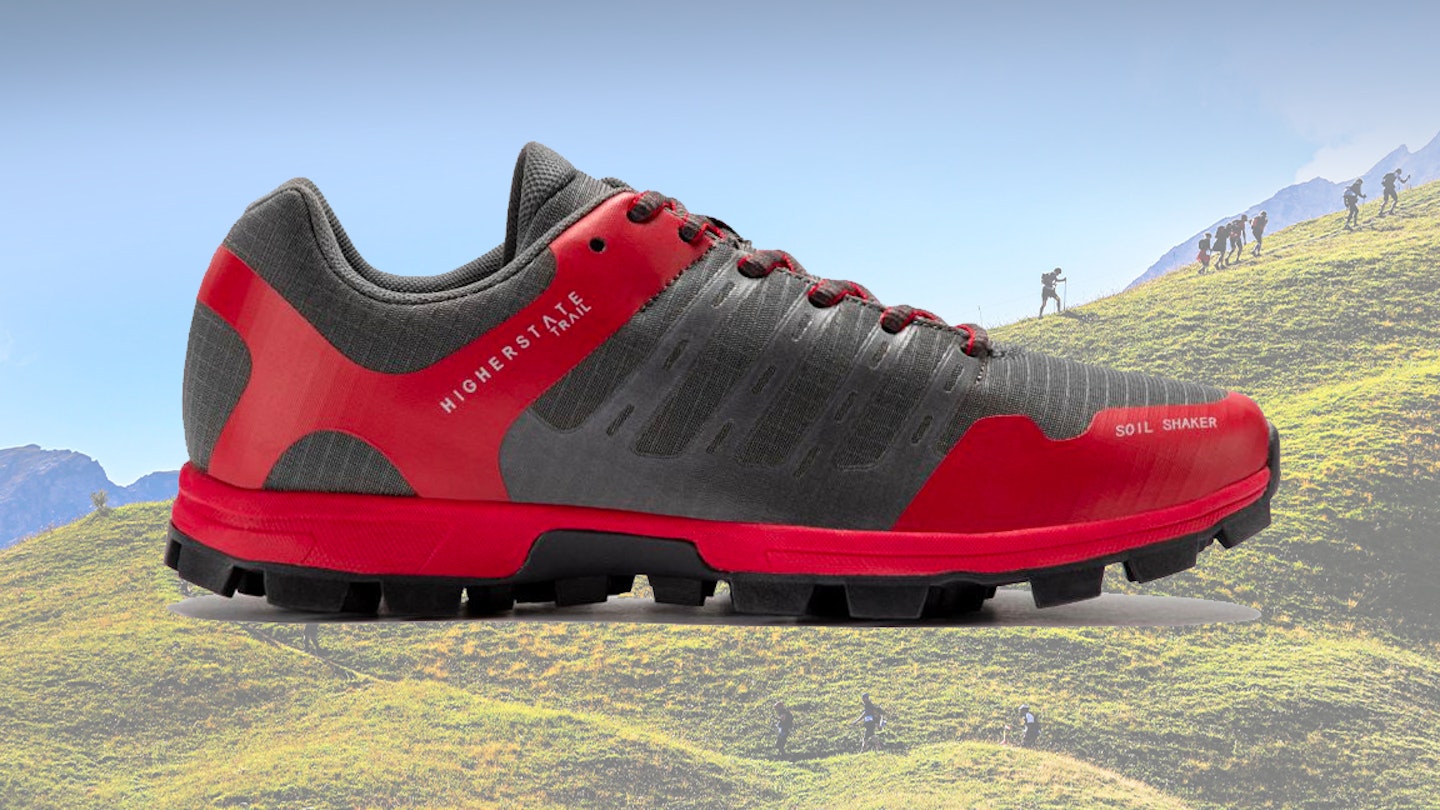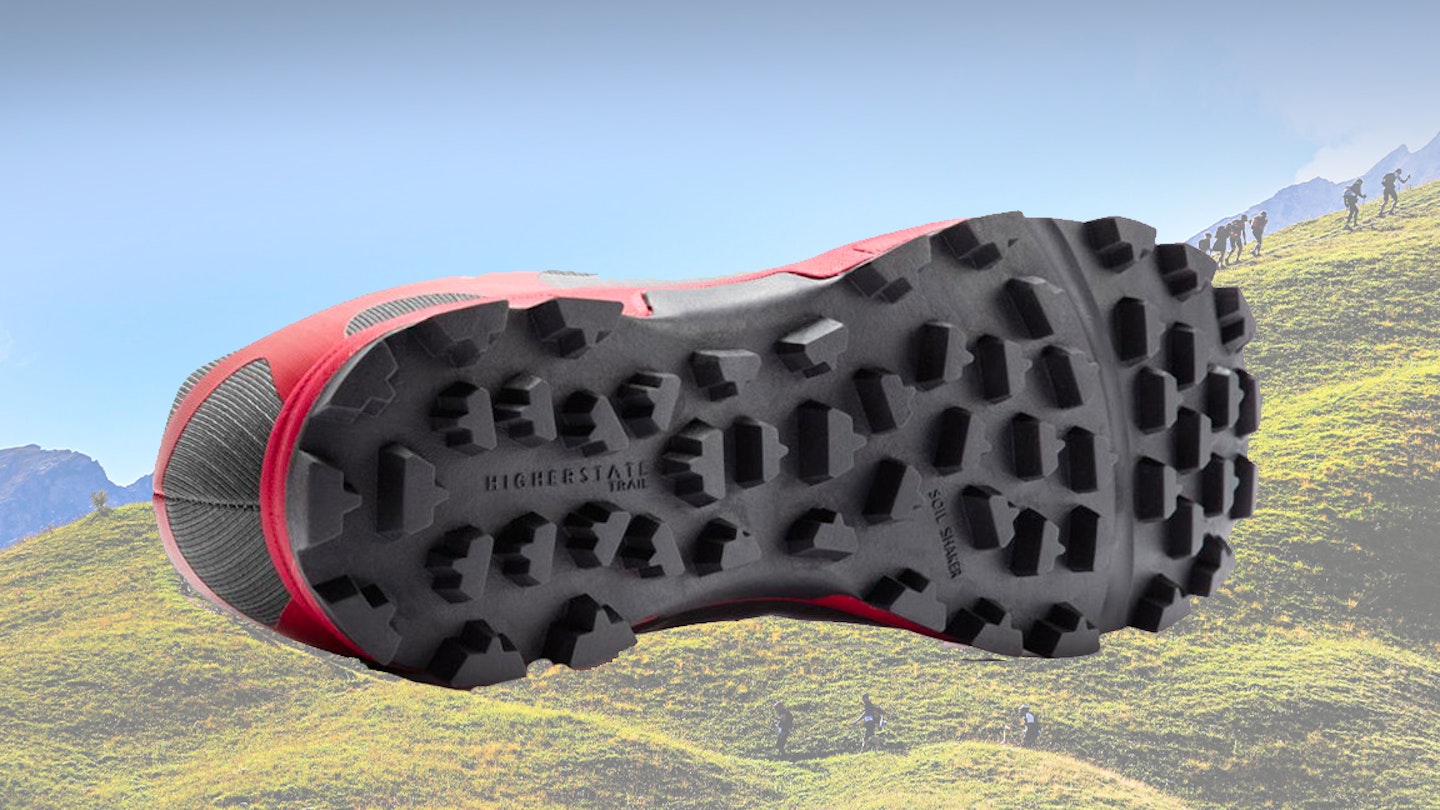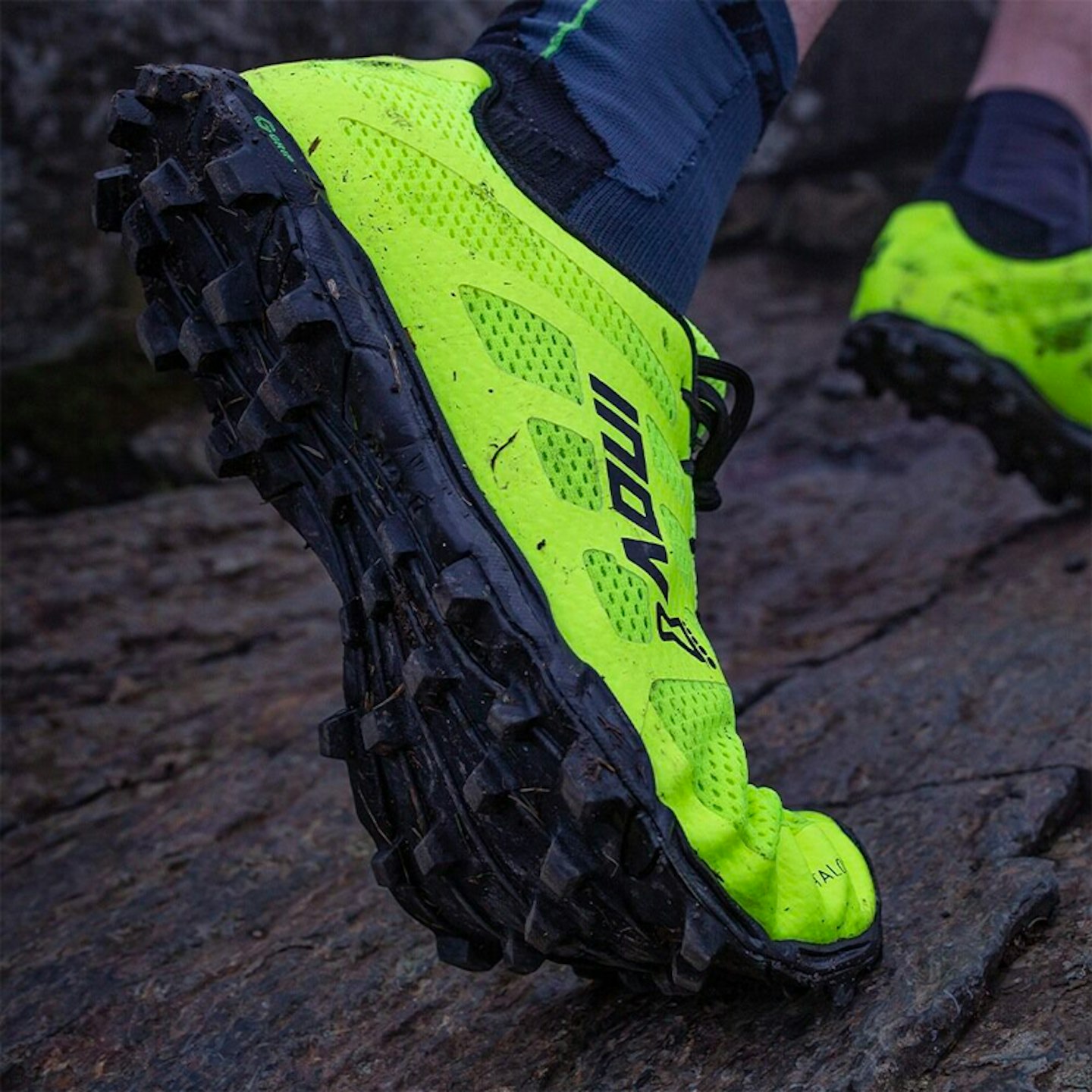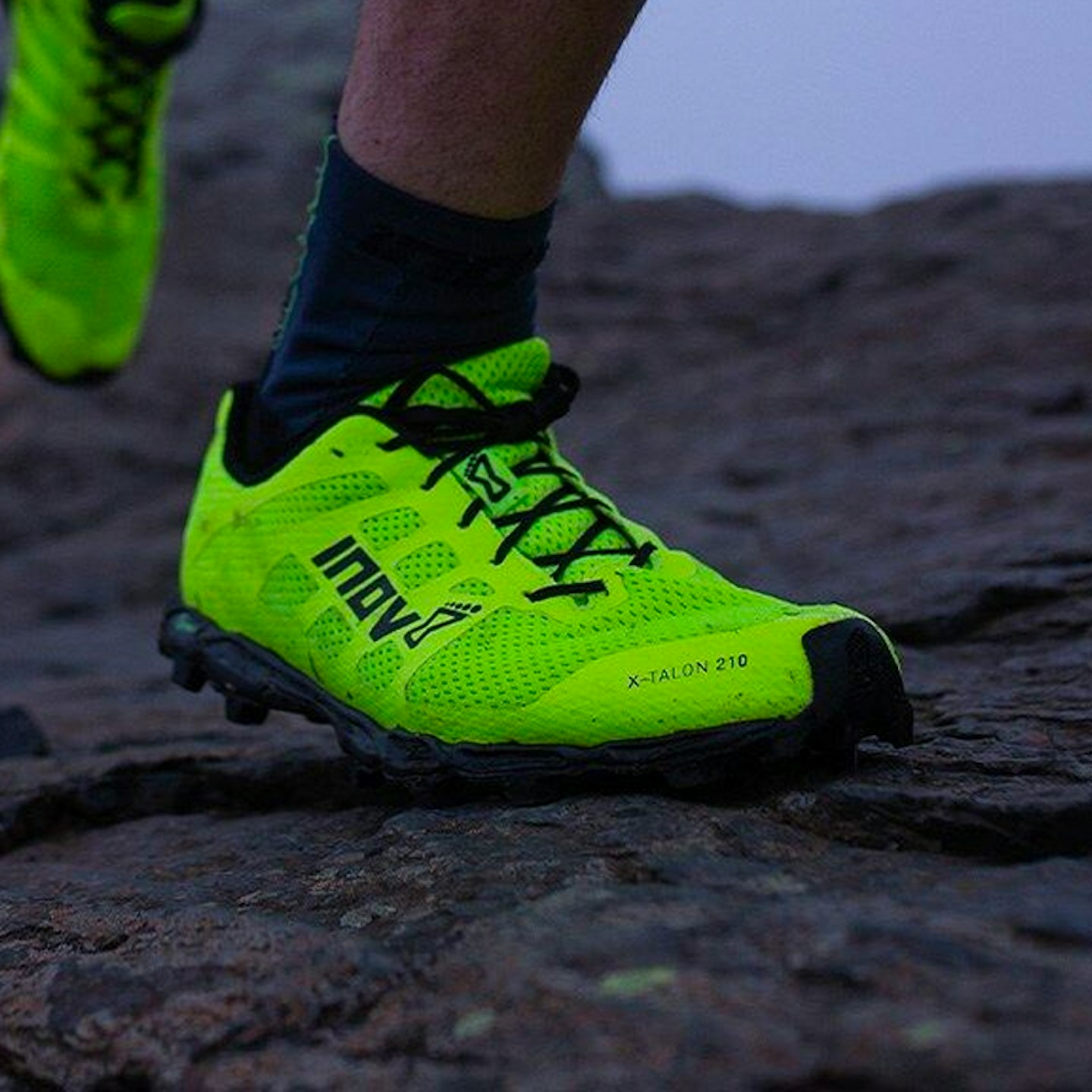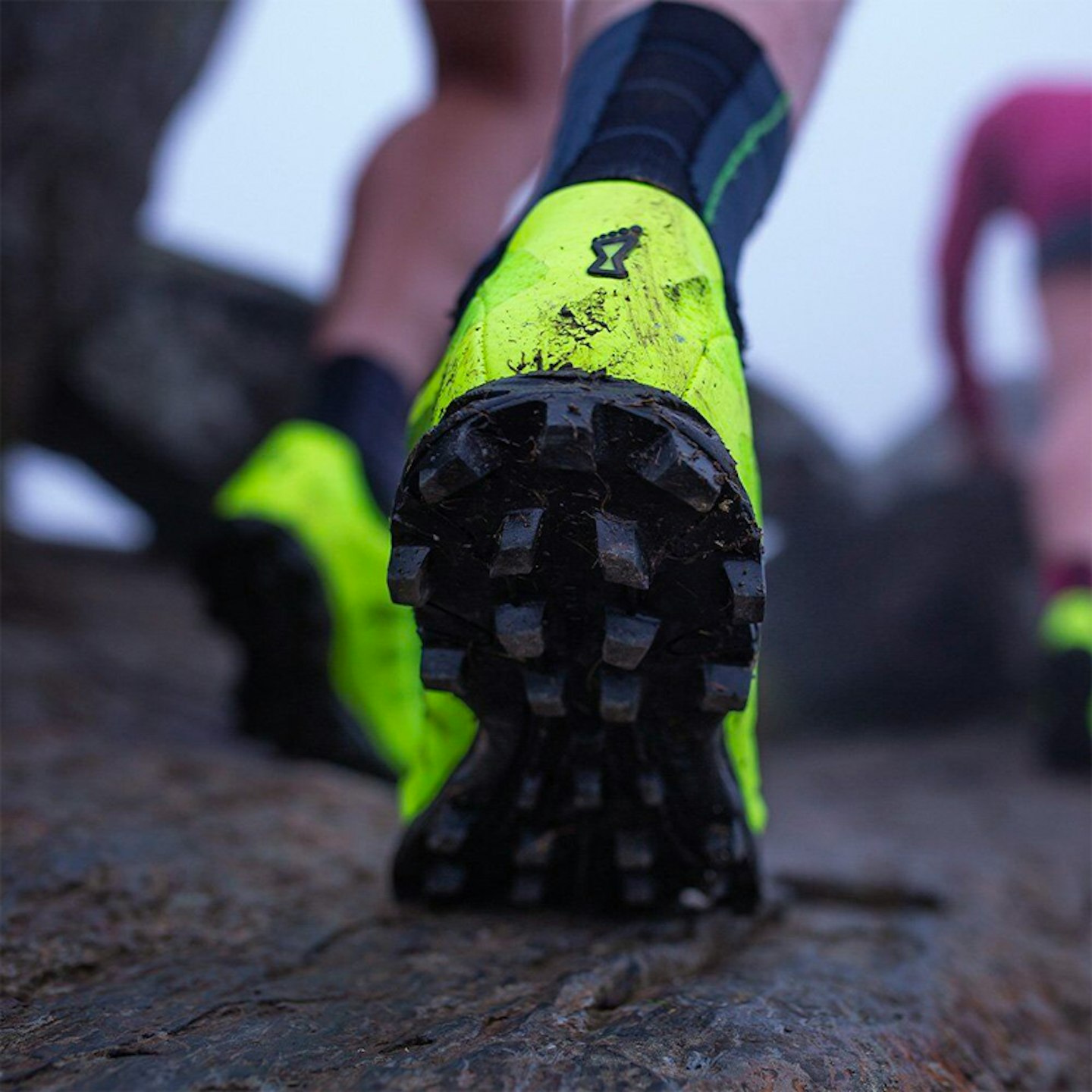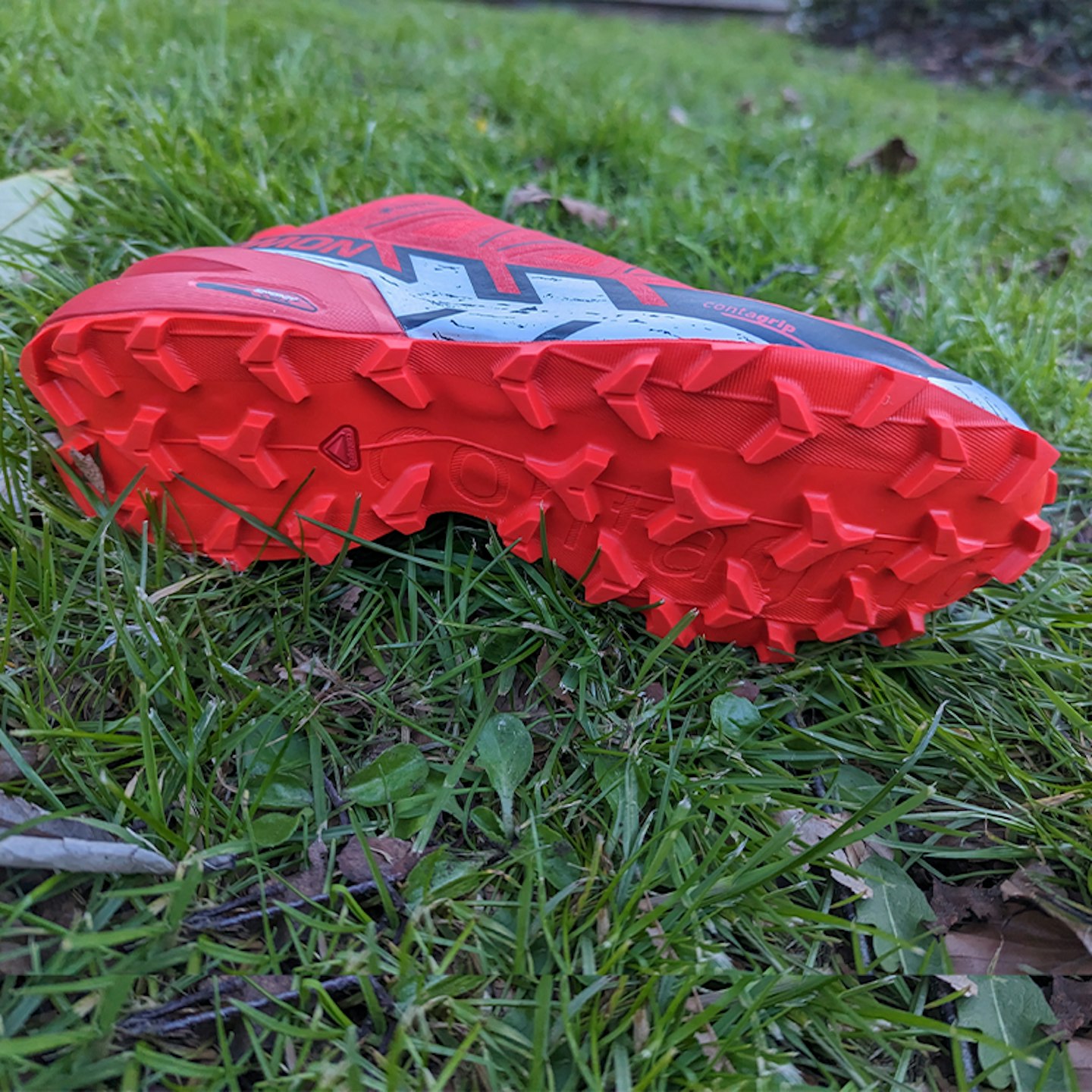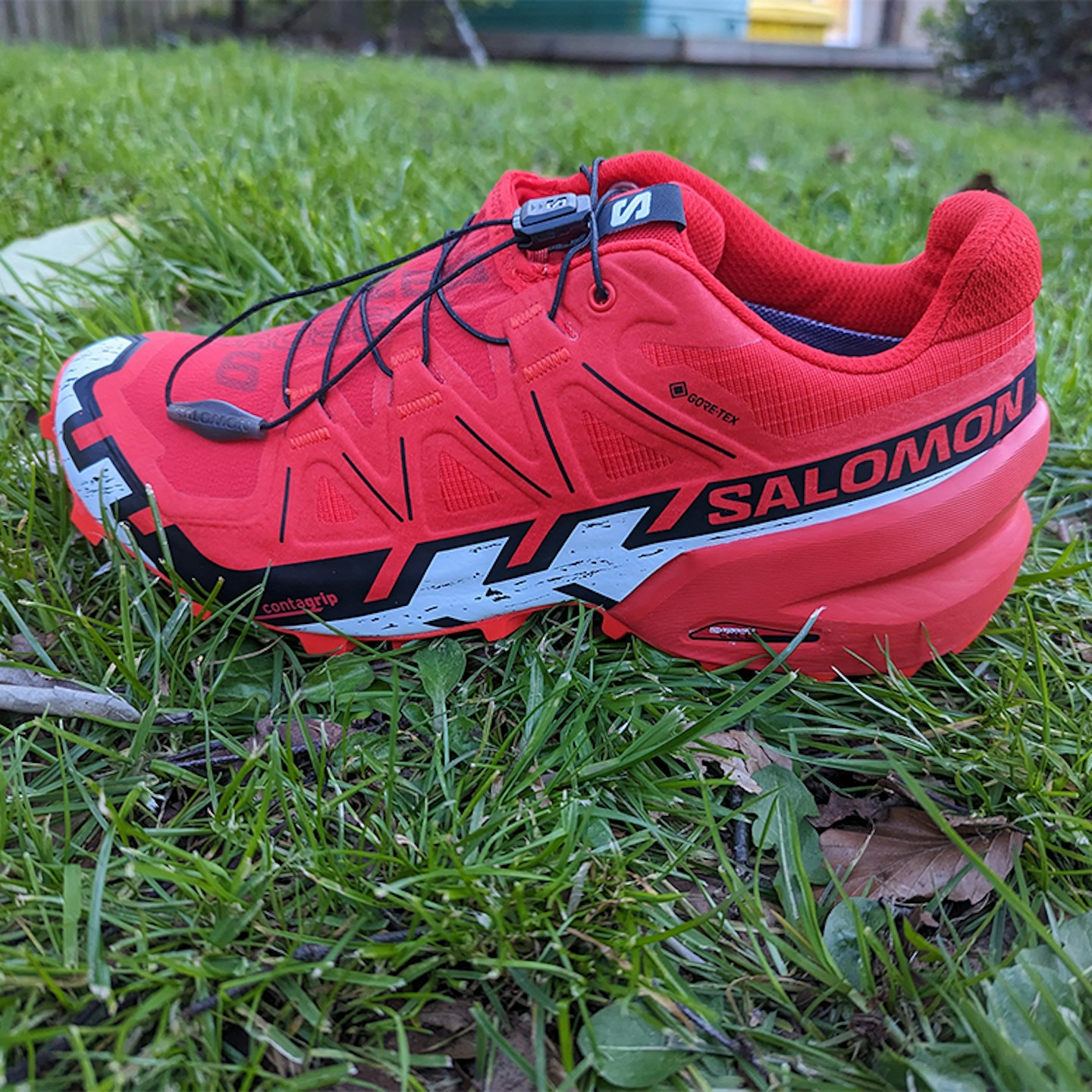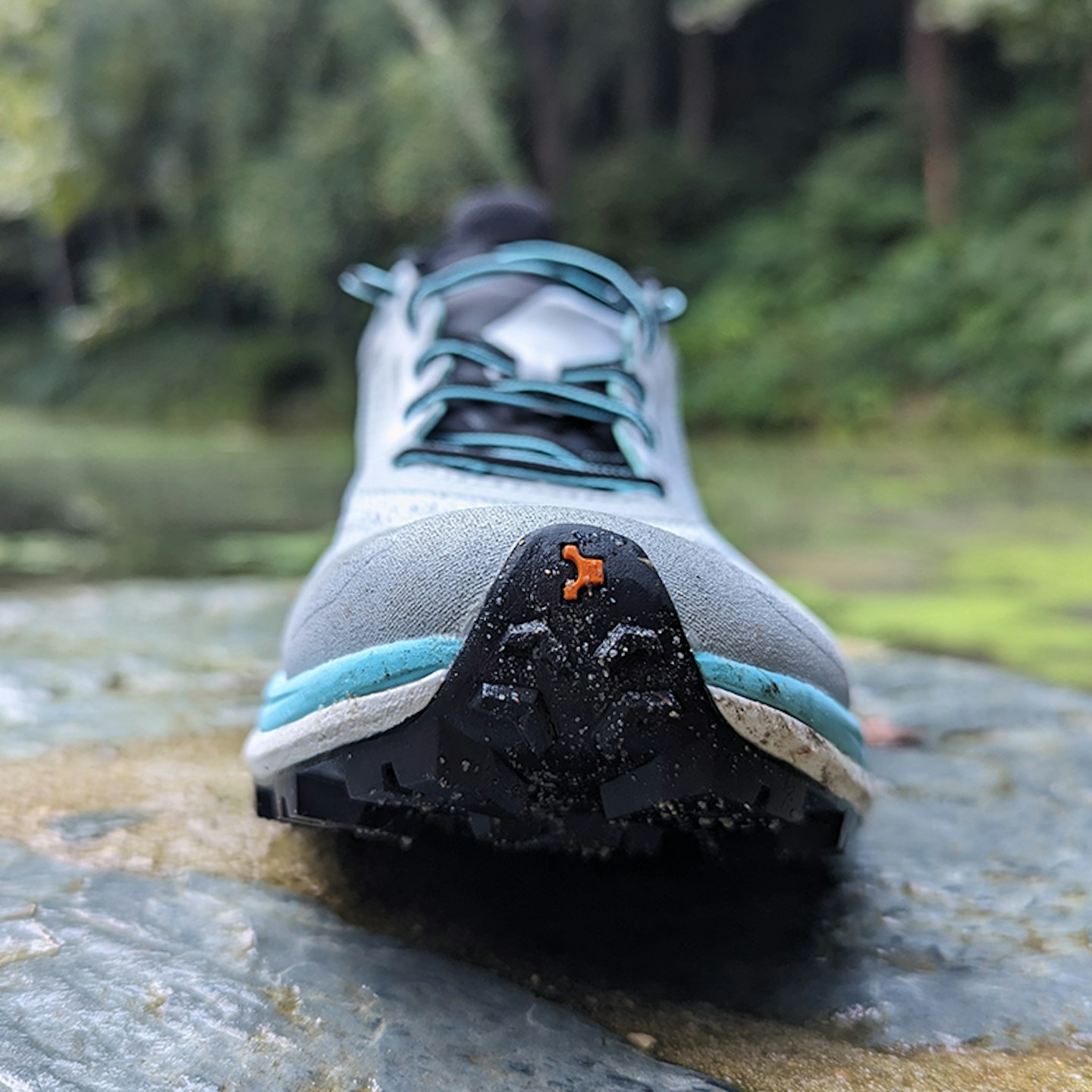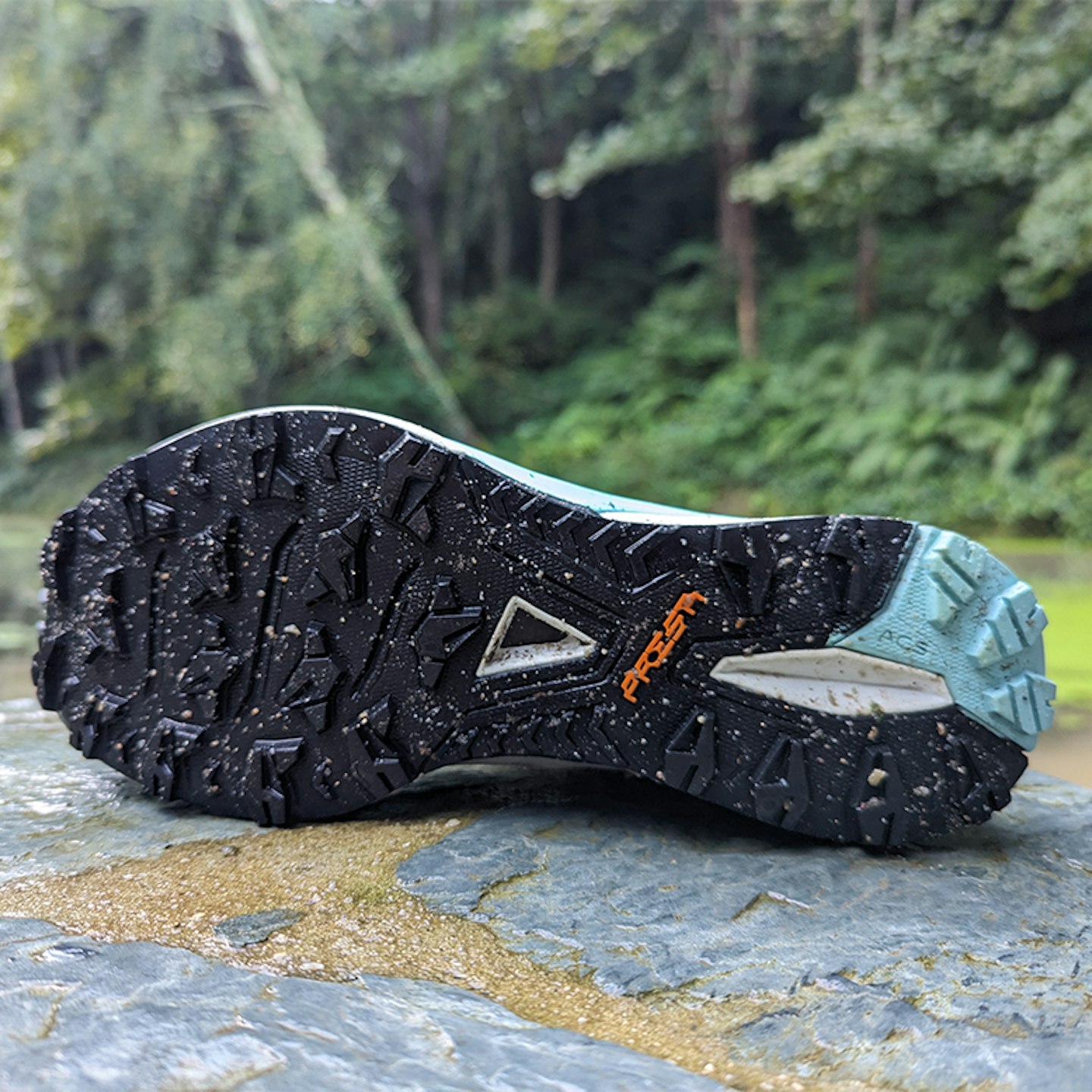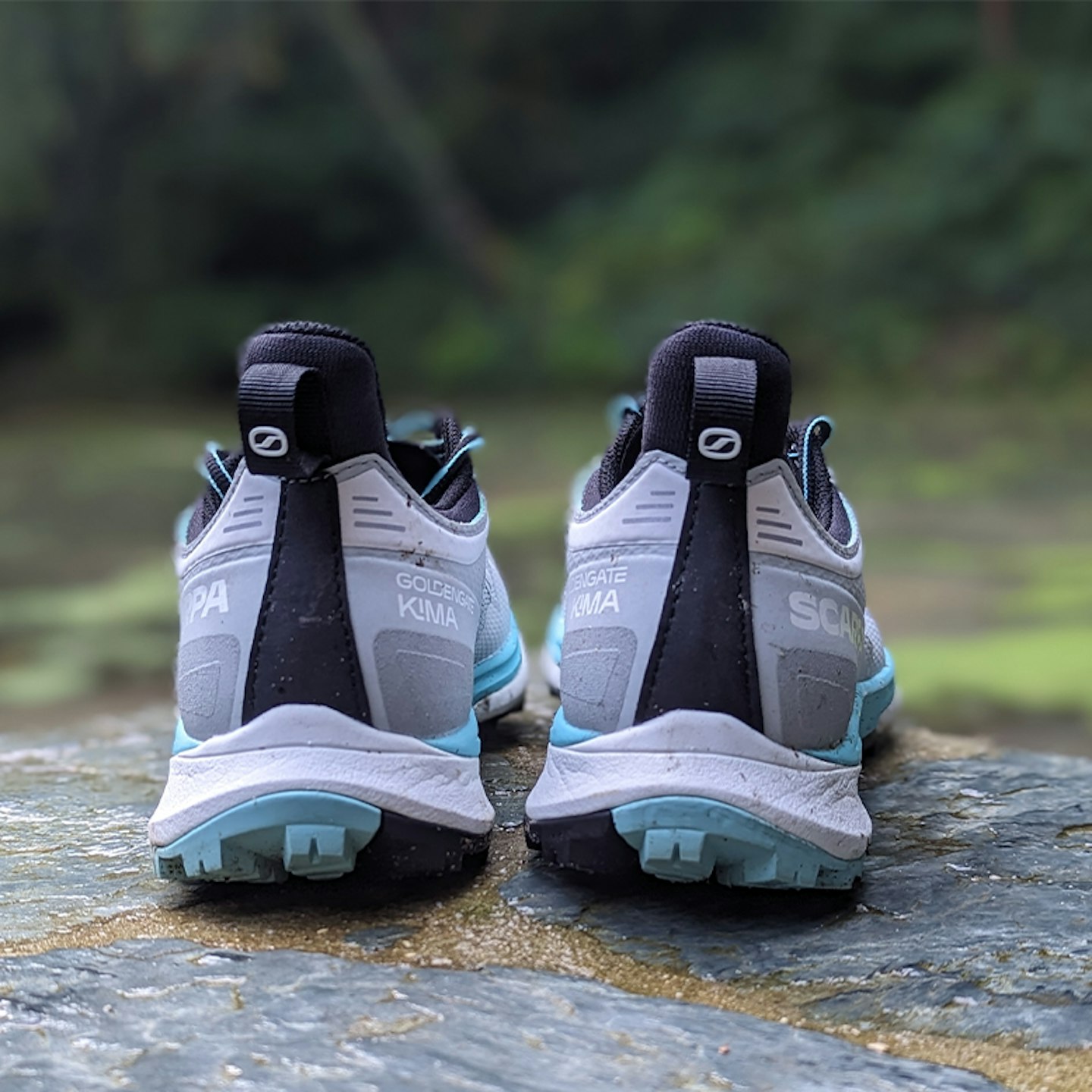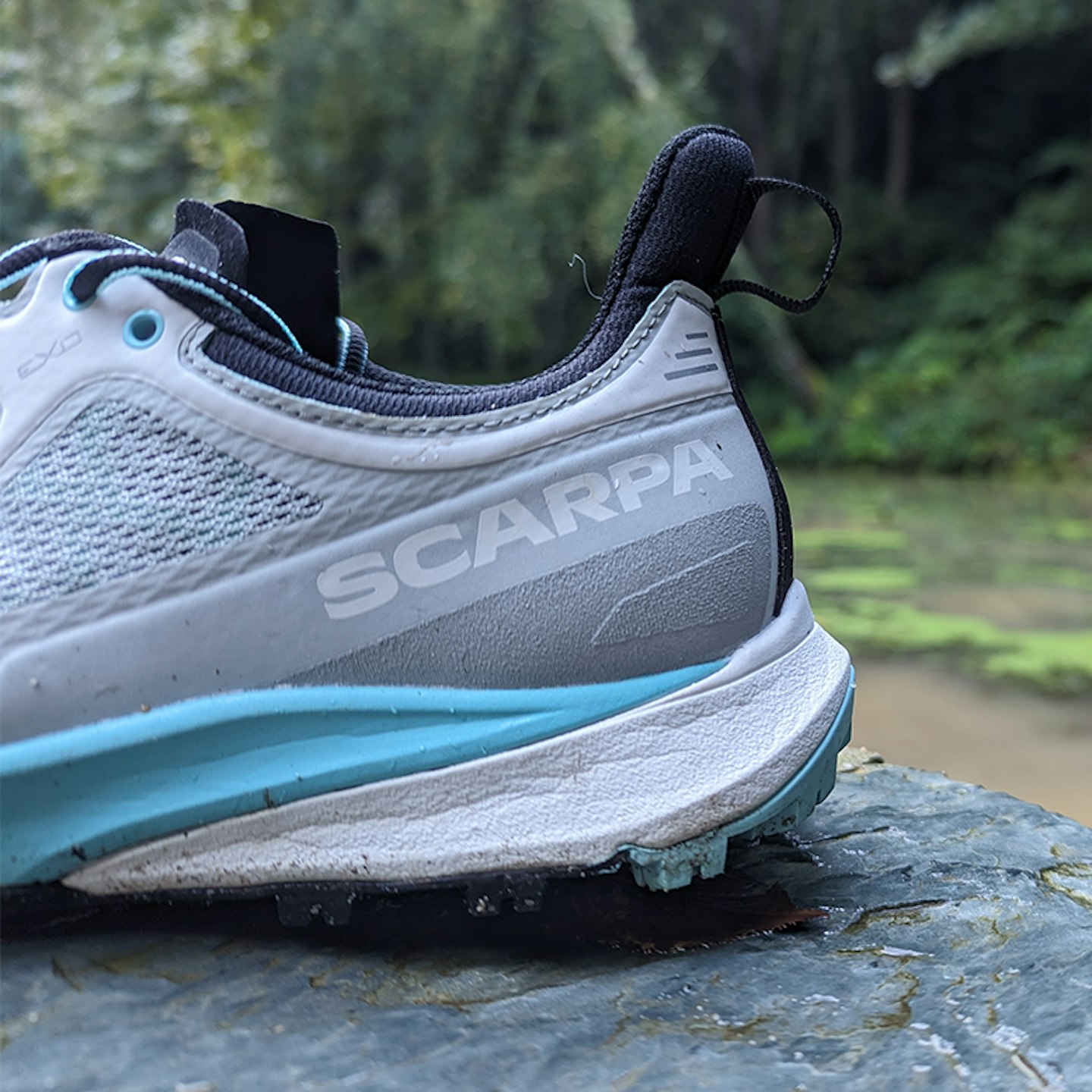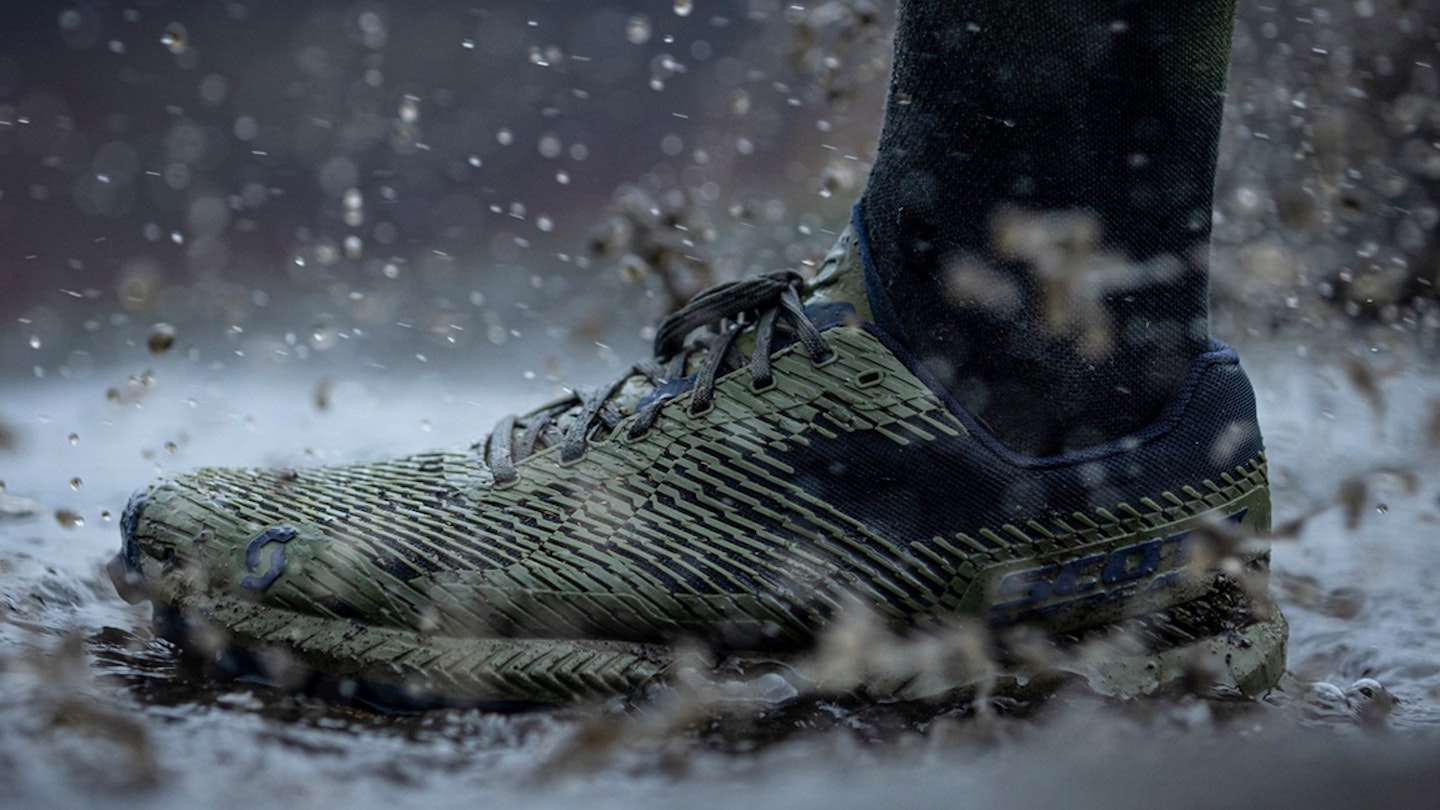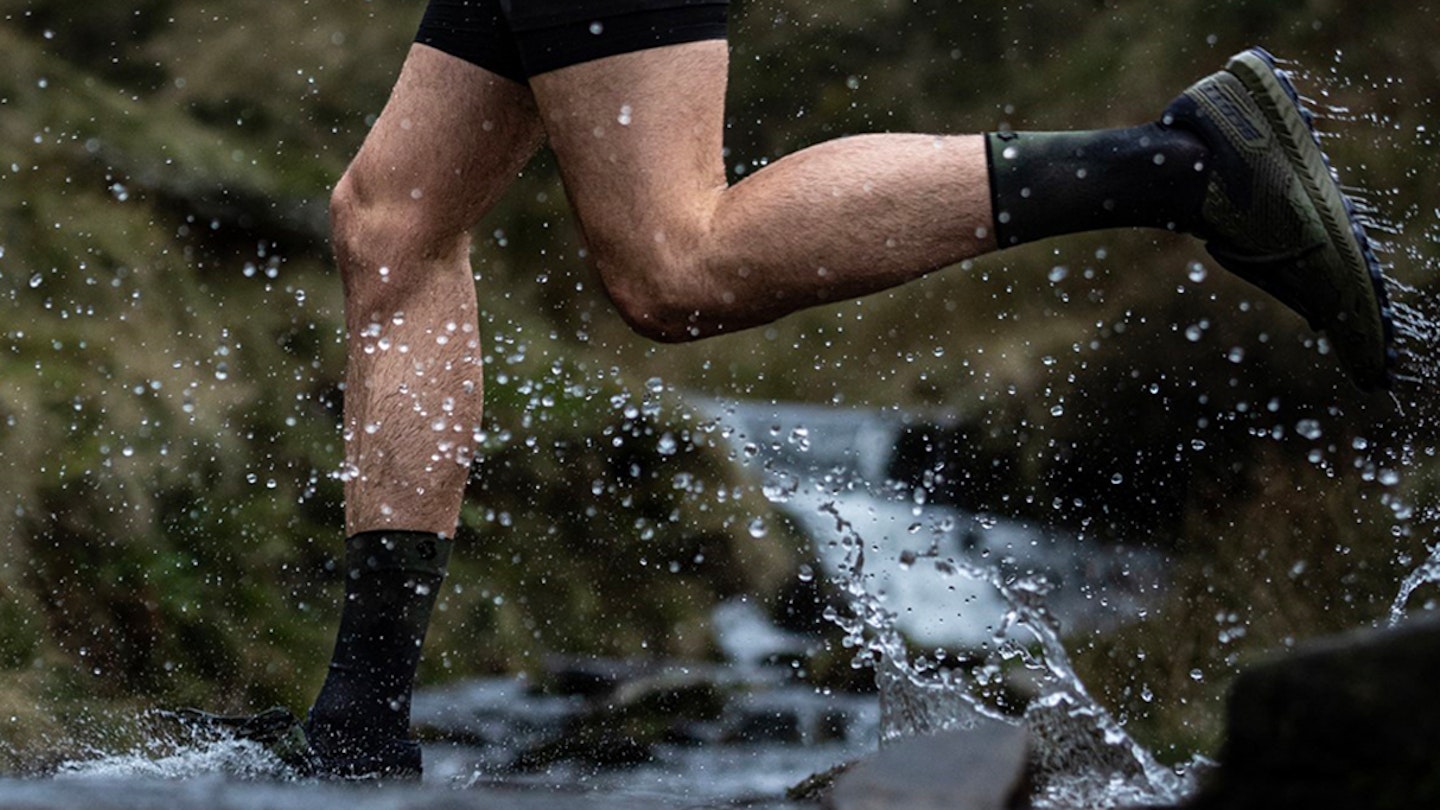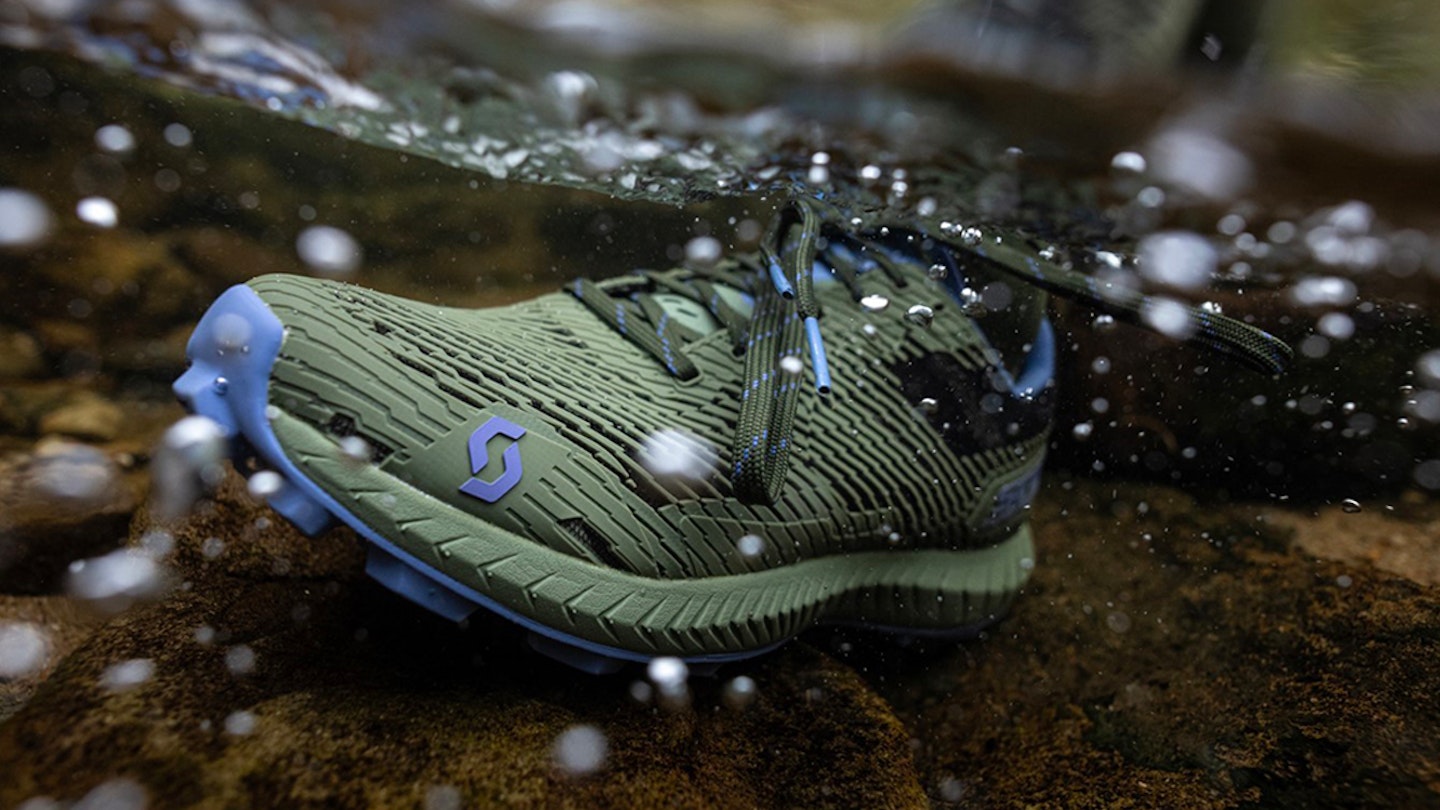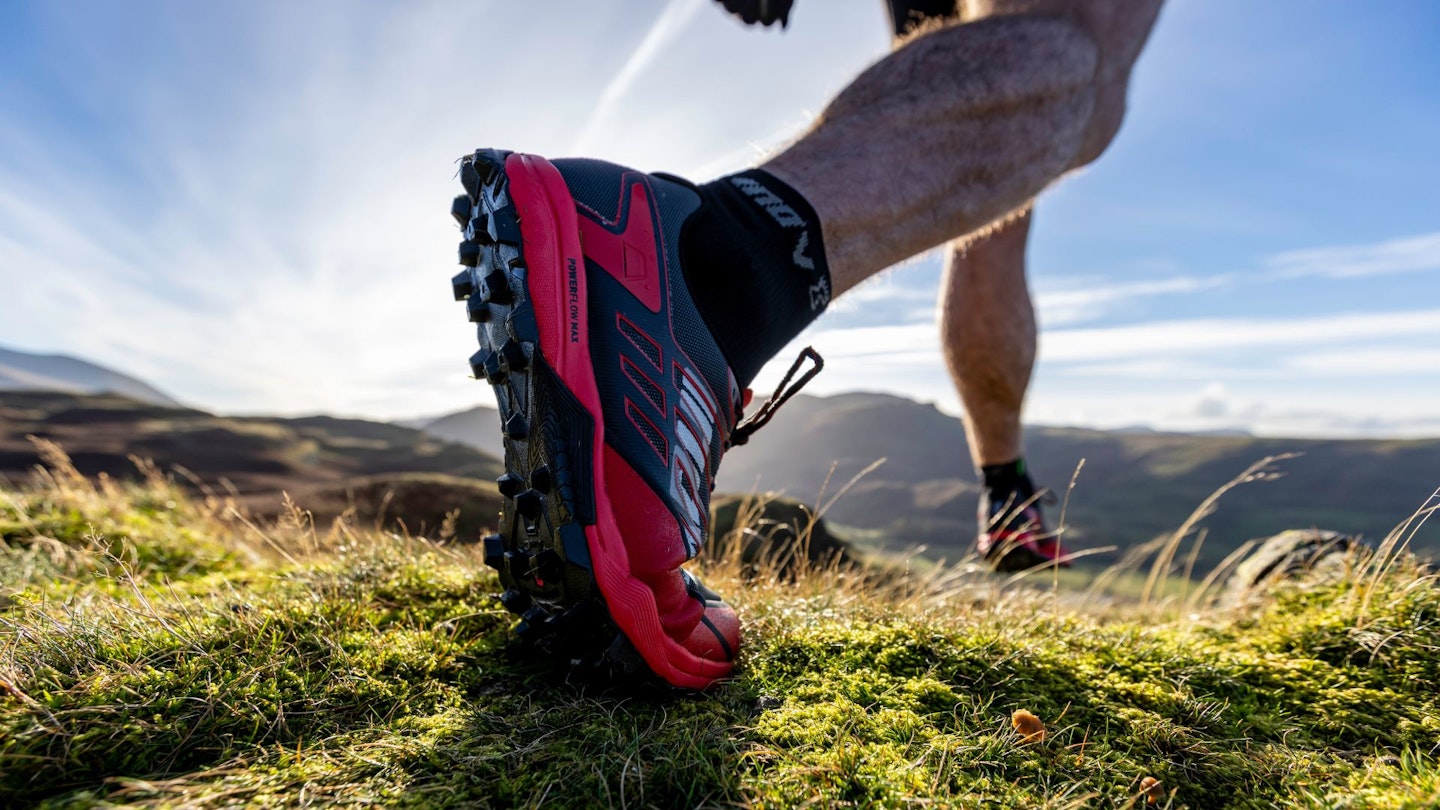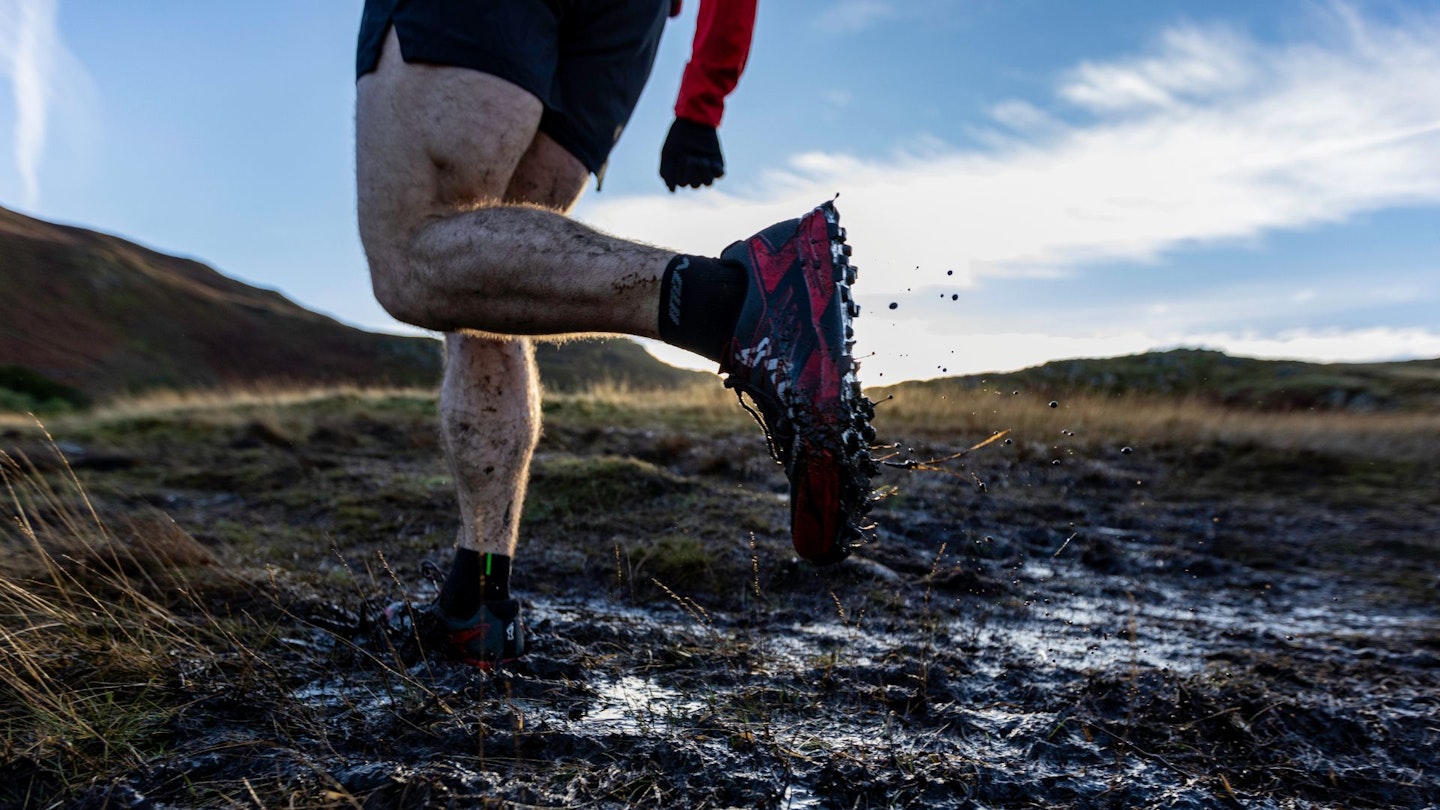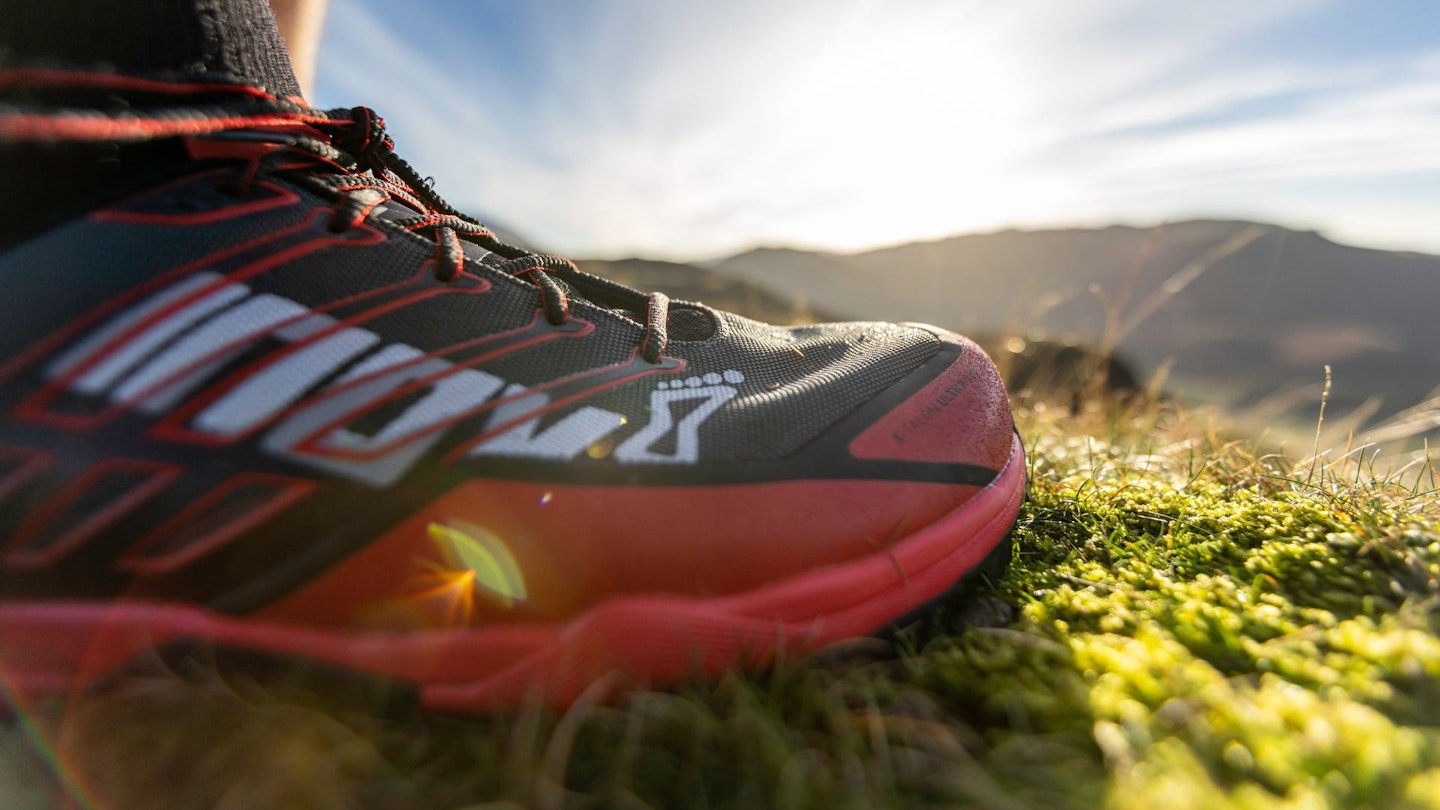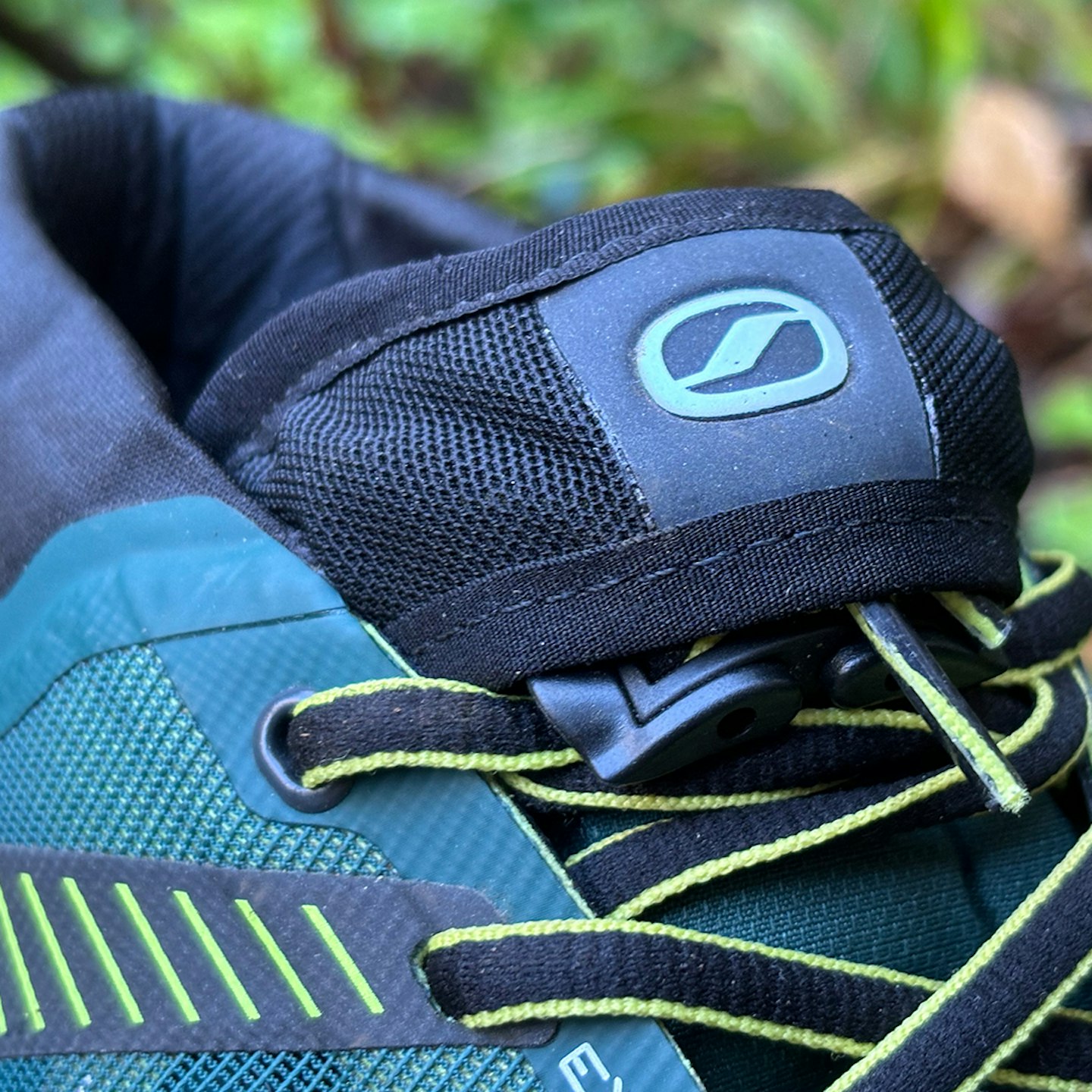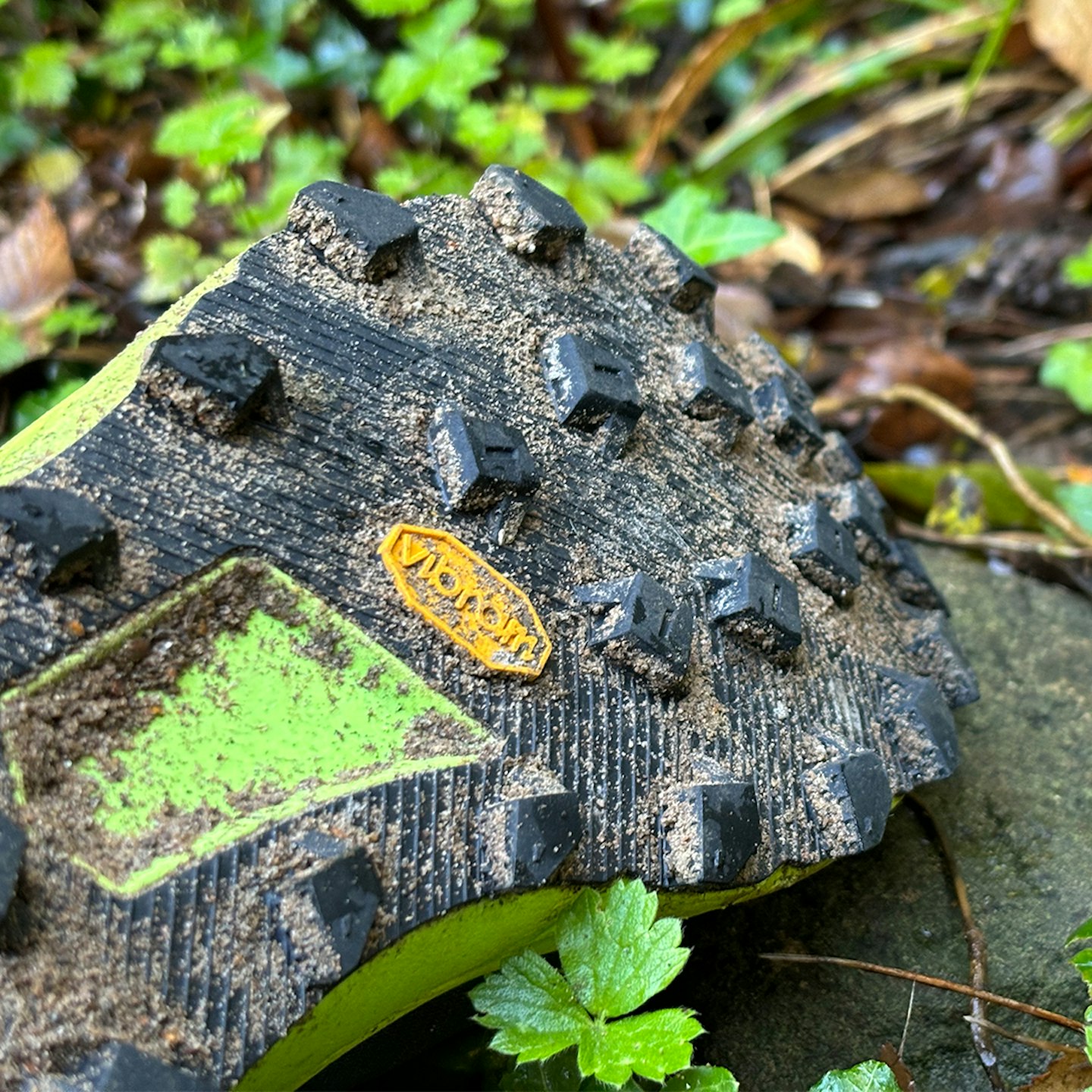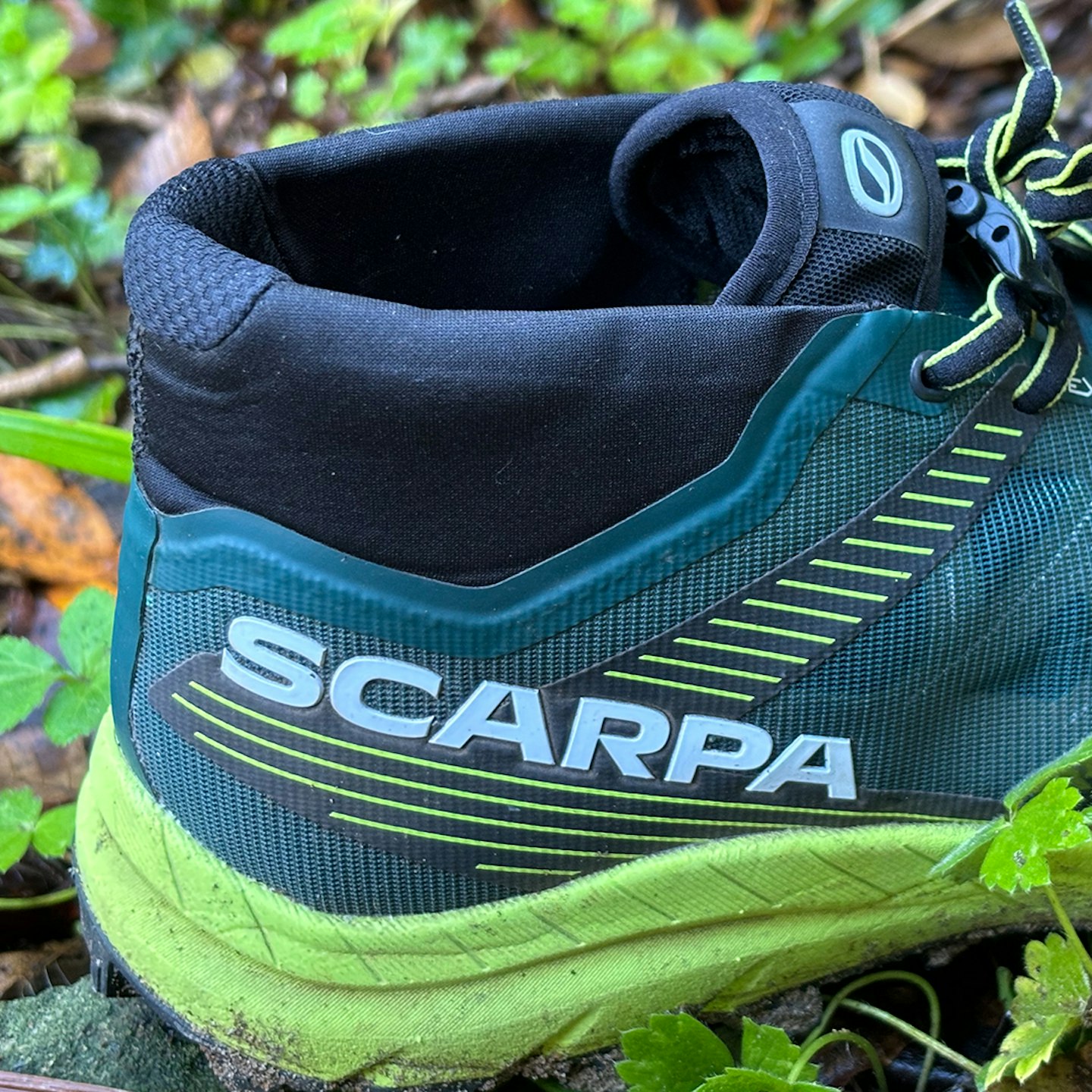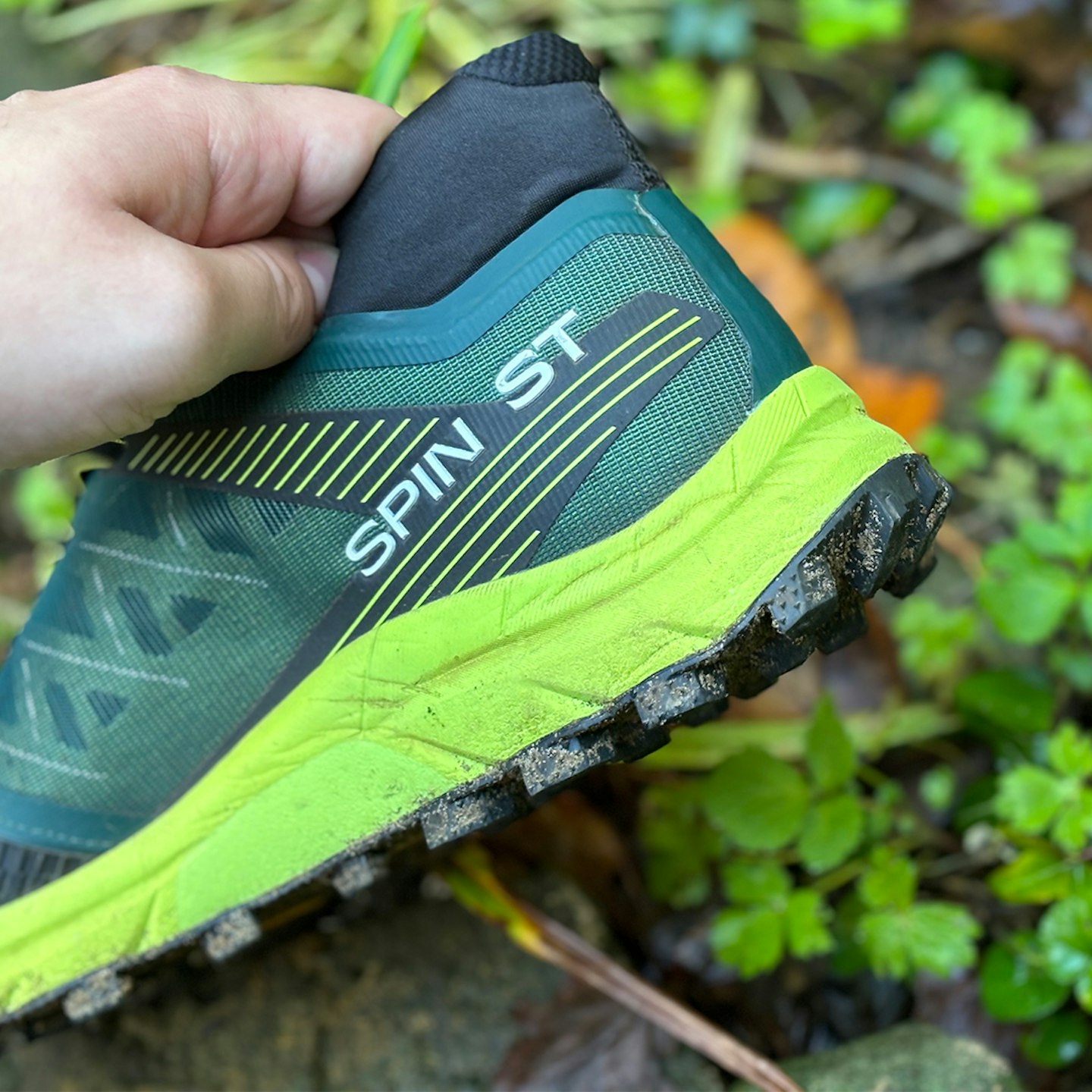The best fell running shoes will provide support and stability when running over rough, off-road terrain. Running shoes for the fells are made to instill confidence when bounding through the thickest mud and most slippy ground.
We’ve gathered our favourite seven pairs of fell running shoes and tested them over all conditions and distances on extreme trails and rough fells. Our favourite fell running shoes have two features at the forefront of their designs: grip and agility.
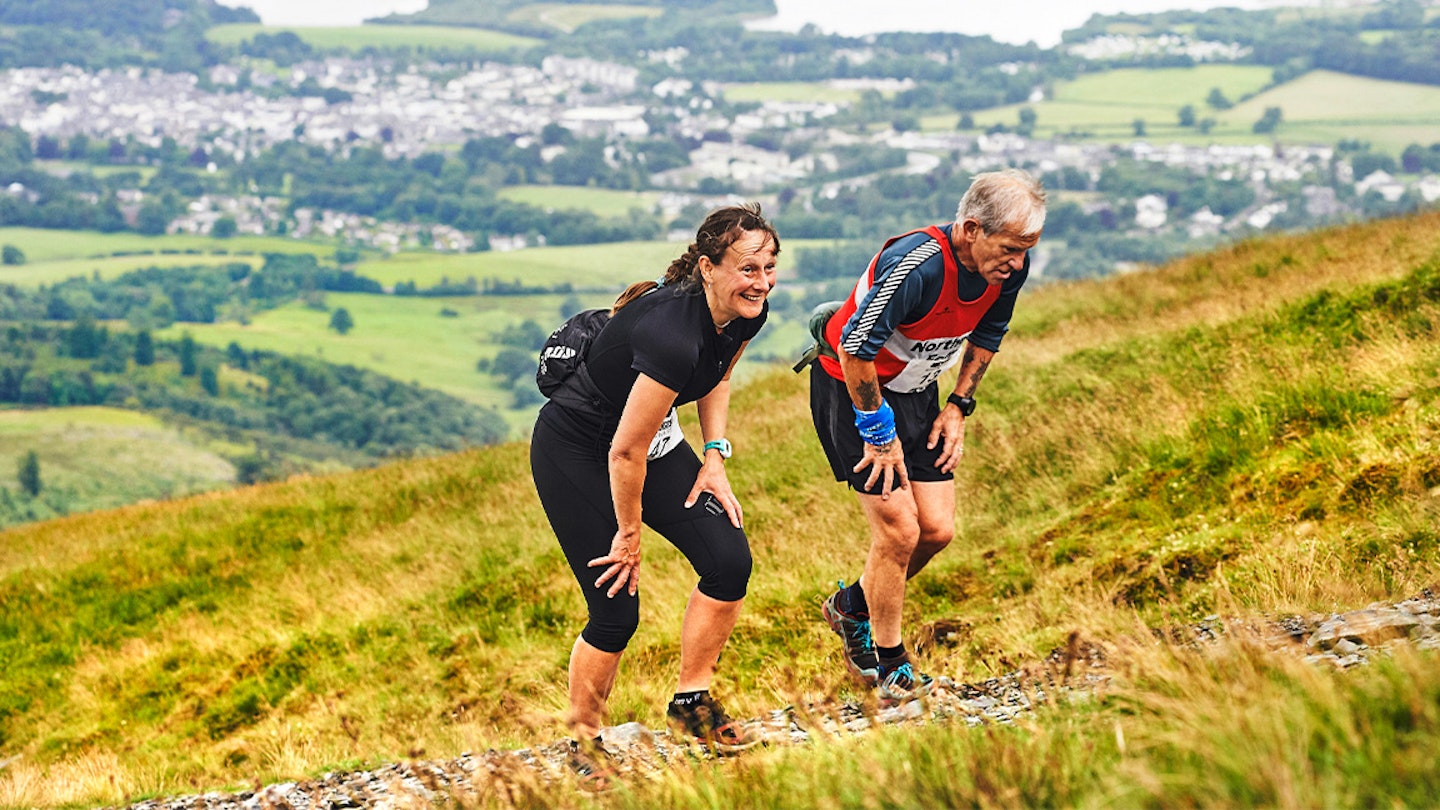
To be able to tackle fells, which include some of the hardest off-road terrain imaginable, then you need a pair of trail running shoes that dig in and provide grip even in thick mud, sloshy underfoot ground, wet rock, and sections of water.
Grip is extremely important in a pair of good fell running shoes and it is our top priority when recommending a shoe to you.
Secondly, agility. With this comes a lightweight shoe, that’s breathable and has a good drainage system. A fell running shoe shouldn’t get clogged up with five kilos of mud, or be as water-logged as your garden paddling pool.
Fell running shoes will feel light and energised on your feet and get rid of any excess debris as soon as you run through it, allowing you to run efficiently, conserve energy, and not get tripped up on the ground you’re navigating.
What are the best fell running shoes of 2025?
Best in test: La Sportiva Mutant
Best value: Higher State Soil Shaker 2
Best lightweight fell running shoe: INOV8 X-Talon G 210 v2
Best waterproof fell running shoe: Salomon Speedcross 6 GTX

How we tested the best fell running shoes
The trail running footwear we test undergo thorough, real-world testing. As soon as they arrive with us, they get allocated to one of our experienced gear testers who take them through their paces over a range of off-road terrain and distances.
We consider myriad factors when testing and reviewing trail running footwear, from the obvious, such as comfort and performance, to the less obvious and intricate, such as sustainability.
Natasha Breen is a contributing trail running gear tester for Live For The Outdoors, within which she specialises in testing women-specific gear and fell running shoes. Tash is a long-distance trail runner and loves taking her dog out on her daily runs.
Graham Sleightholme is an expert writer and trail running gear tester for Live For The Outdoors. He's tested copious trail running shoes and specialises in winter trail running gear. Graham enjoys racing half marathons and marathons out in nature on the trails. For more info about we test outdoor gear, click here.
Best fell running shoes in detail:
The La Sportiva Mutant is a stylish mountain running shoe designed to handle challenging trails. It features a split tongue with spiral side lacing system and integrated gaiter to keep debris out and provide a snug fit.
The Mutant offers excellent comfort with plenty of cushioning and a padded tongue which spreads pressure and secures the heel. It has a mesh pocket to tuck laces in, and a convenient heel loop for easy removal.
Coming in at 310g (size UK8), it's not the lightest fell runninign shoe reviewed here, but for the weight you get substantial protection and support, with a 10mm drop and comfortable EVA moulded midsole which comes together to stabilise the foot nicely.
The sticky FriXion rubber outsole with 6.5mm multi-directional lugs offers exceptional traction over a wide range of terrain. It excels on rocks, uneven surfaces, and wet boggy trails, instilling confidence for both ascents and descents.
The upper is made of anti-abrasion air mesh nylon, which allows it to remain breathable and efficiently drains water and mud. A double reinforced toe bumper adds even more protection.
The shoe accommodates wider feet in the toe-box, but tends to run small in overall size, so sizing up by a half-size is recommended. Overall, the La Sportiva Mutant has to be our absolute favourite choice for fell running as it offers comfort, protection, and outstanding traction.
Pros
- Good foot hold
- Great grip and traction with 6.5mm lugs
- Comfortable for longer distances
Cons
- On the heavier side
| Women's sizes | UK3.5 - UK9 |
| Men's sizes | UK5 - UK12.5 |
| Waterproof version? | No |
| Weight (SIZE UK8) | 310g |
| Drop | 10mm |
| Stack height | 26mm/16mm |
| Lugs | 6.5mm |
The Higher State Soil Shaker 2 is a fell and mountain running shoe from Sportsshoes.com's own brand range. The Shaker immediately make a bold impression with their red and black design which is reminiscent of bowling shoes, but in the best way. The shoes are quite chunky due to generous padding, especially around the top and the tongue. While this cushioning does a good job of adding comfort and preventing rubbing, it does mean that moisture is retained when wet.
To counteract moisture retention, the upper is constructed from a dual mesh that allows water to escape and provides breathability during warm runs. The shoe has well-placed reinforcement via the PVC overlay in high-wear areas, but we were disappointed to see a split in this material after a few long runs (this didn't affect functionality though). The lacing system keeps the shoes secure but were too short to double-knot and had to be replaced.
Meanwhile, the 7mm multi-directional lugs provide excellent grip in muddy conditions, with efficient water drainage, and the rubberised material offers solid traction even in wet environments. The 8mm drop and moulded insole offer comfort, protection, and support on uneven surfaces, with the flex groove at the forefoot allowing for natural movement.
At 380g, these shoes are heavier than many trail shoes and, combined with the padding, can feel bulky. We found them true to size and a good fit for wide feet.
Pros
- Great grip
- Good drainage
- Lots of padding
- Amazing value for money
Cons
- Heavier and more clunky than some
- Questions over longevity
| Sizes | UK7 - UK13 |
| Waterproof version? | No |
| Weight (size UK8) | 380g |
| Lugs | 7mm |
| Stack | Not specified |
| Drop | 8mm |
The Inov-8 X-Talon G 210 V2 is a trail running shoe designed for fast running over uneven and technical terrain. Tested over long distances across fells and extra muddy trails, the X-Talon impresses with its combination of flexibility, toughness, and low weight.
The fluorescent yellow colour enhances visibility on the trails, making it an ideal choice for cross-tri athletes and fell runners, particularly in winter. The shoe's 8mm graphene lugs provide excellent traction, while Inov-8's lightweight graphene-enhanced outsole rubber offers impressive grip and durability, even on wet rocks.
Meanwhile, the Cordura mesh upper allows for breathability and quick water expulsion, making the X-Talon suitable for particularly wet runs or a swimrun athlete. However, we found that the shoe lacks substantial padding, which may not suit those needing more arch and ankle stability.
The X-Talon performs exceptionally well on hills and fells but is less comfortable on short stretches of road due to limited shock absorption and long lugs. It's worth bearing in mind that you can't have both the extremely long and grippy lugs you find in winter trail running shoes and the same level of comfort you'd find over hard ground in a road to trail running shoe - it's one or the other. In a good fell running shoe, grip and agility should be prioritised above all else.
Overall, the X-Talon is a well-made, lightweight, and durable shoe best suited for tackling extreme and muddy terrain you'd find on the fells. While it may not provide enough support on harder surfaces, it's an excellent choice for trail runners who prefer a natural, close-to-the-ground feel.
Read our extended review of the Inov-8 X-Talon G 210 V2 here.
Pros
- Lightweight and nimble
- Very grippy Graphene outsole
- Adds to visibility
Cons
- Not very cushioned
- Low drop won't suit all
| Women's sizes | UK3 - UK9.5 |
| Men's sizes | UK6 - UK13 |
| Waterproof version? | No |
| Weight | 210g |
| Drop | 3mm |
| Stack height | 9mm/6mm |
| Lugs | 8mm |
The newest iteration of Salomon’s much-loved Speedcross trail running shoe, the Speedcross 6 GTX is designed to take on muddy trails and rough off-road running with more grip and at a lighter weight than its predecessor.
We tested the Gore-Tex version, which has all the features of the classic Speedcross 6 (£140) while also being fully waterproof, adding to the shoe’s durability. The Speedcross 6 has a host of really functional elements, including the Quicklace system, which fits smoothly against the upper and has a simple pull and lock mechanism, while any extra lace can be tucked into a mesh pocket at the top of a tongue.
This comes together to give a nice firm lock to the heel, while the strong Energy Cell+ EVA midsole manages to provide enough cushioning that it doesn’t feel too rigid.
There is a total commitment to trail with a solid toe box, ergonomic Ortholite insole and a solid Contagrip outsole. When it comes to grip, the Speedcross 6 comes up with the goods, the 5mm lugs inspiring confidence on the most technical of terrain and both up and down hills. Mud isn’t an issue and that lug spacing throws most straight off.
The sixth iteration also comes in a touch lighter than the previous model as well. So while the Speedcross 6 won’t provide the comfort of a road to trail shoe, it does excel as a pure off-road shoe that you can rely on to be protective and super grippy, while remaining agile enough for the fells.
Pros
- Fully waterproof and easy to clean
- Quicklace system
- Firm heel lock
- Grippy lugs
- Made from recycled materials
Cons
- May be a touch too heavy and rigid for some
- Best suited to narrower feet
| Men's sizes | UK6.5 - UK13.5 |
| Women's sizes | UK3.5 - UK9.5 |
| Waterproof version? | Yes, Gore-Tex |
| Weight | 328g |
| Lugs | 5mm |
| Stack | 33mm/23mm |
| Drop | 10mm |
The Scarpa Golden Gate Kima RT is a specialised trail running shoe designed for fast fell running. The shoe has speed-optimised features, including its 'new generation foam' midsole, which is designed to optimise foot arch elasticity, thus reducing energy expenditure while running. It's 6mm drop would best suits those with average foot geometry and arch height who are looking for a neutral shoe.
The shoe's midsole incorporates a double-density layer called 'Active Foam' with the 1mm carbon plate sandwiched within. It has a precise fit, due to a reduced-volume last with a sock-fit construction and internal lateral stability cage, which just moulds to the foot without being tight and uncomfortable.
What sets the Kima RT apart is its remarkable propulsion, thanks to the carbon plate, curved rocker-like shape, and springy midsole foam, all combining to create a quick and responsive run feel. The Kima RT is relatively lightweight at 255g per shoe (UK5) and provides excellent ground feel due to its slim stack height.
All important traction is achieved through the 4mm arrow-shape lugs, which provide a surprising level of traction for their length and can handle both mud and boggy fells. Of course, where the Kima RT excels is over hard-packed off-road terrain since the carbon plate can retain foot down to toe-off running power.
Read our full review of the Scarpa Golden Gate Kima RT here.
Pros
- Great rebound and power
- Improves energy and running efficiency
- Lightweight and agile
- Good ground feel without compromising on comfort
Cons
- Less affordable than others
| Women's sizes | UK3.5 - UK8 |
| Men's sizes | UK6.5 - UK13 |
| Weight (size UK5) | 255g |
| Drop | 6mm |
| Stack height | 22mm/17mm |
| Lugs | 4mm |
The Supertrac Amphib are Scott’s first shoe designed specifically for multi-sport events, including obstacle course races and swimrun events. Above all, Scott prioritises good drainage and traction in the Amphib, which is covered in a striking plastic mesh KPU coating to allow for optimal drainage while running. The covering is also designed to increase durability of the shoe, which quite literally is made to go through the wringer, and be able to keep running afterwards.
The drainage system works excellently in wet weather, with plunging through streams and wet trails adding no extra weight to the shoe. However, we found that the coating started to degrade and even come away in small sections after some longer distance runs, so we’d keep the Amphib for the short stuff.
The performance tongue and good lacing system also helps keep the shoe firmly in place, though a quick-lacing system would be preferred to avoid re-doing soggy laces. There’s a reinforced toe box to stops injuries to the toes and a good amount of padding around the ankle.
On the most part, the 6mm lugs are well-placed to stop the Amphib from getting blocked up with mud. Disappointingly, there were lacking in grip over hard wet surfaces which should have been the main selling point of the shoe.
The Amphib has a moderate 5mm drop and slim stack, which enabled us to maintain good ground feel while running. Meanwhile, the midsole has a curve which Scott dubs the e-ride, we found it did its job in offering a more stable mid-stance and promoting a faster more efficient running style, though increased the shoe’s rigidity in doing so.
The lightweight and agile shoe comes in at a slim 280g for our UK8, though it’s worth bearing in mind that performance fit is a narrow one, so we’d recommend going up half a size to your normal digits.
Pros
- Great drainage and copes in wet conditions
- Lightweight and agile
Cons
- Lack of grip on wet rock
- Concerns over durability
| Women's sizes | UK3 - UK8.5 |
| Men's sizes | UK6 - UK12 |
| Waterproof version? | No, but drains well |
| Weight (UK8) | 280g |
| Drop | 5mm |
| Stack height | 22.5mm/17.5mm |
| Lugs | 6mm |
Inov-8 says the new and updated version of the popular X-Talon Ultra 260 V2 trail running shoe now comes with an improved fit and locked-in feel. The new, feather-thin tongue stays in place when laced up, with no rubbing or shifting. While ample ankle and footbed padding complements the 9mm/6mm midsole stack for comfort on rugged terrain.
With 8mm 'Graphene Grip' lugs, the Talon provides impressive traction without feeling heavy, weighing in at 260g. They handle tree roots and rocks well, instilling confidence even during night runs. The shoe's stability is reassuring, and it sheds mud efficiently, maintaining a solid grip even on the slippy stuff.
The grip remains consistent on steep inclines and declines, while the large toe bumper and 'ballistic nylon' upper offer protection and durability. Though not fully waterproof, the Talon handles wet conditions effectively and drains well.
Overall, we found the Talon to be a great choice for fell running as they excel in comfort, grip, and durability, making them suitable for running in challenging weather conditions. Despite being known for its wider toe fit, they accommodated our tester's narrow feet well, providing a good heel lock but also leaving ample room for swelling over longer distances.
Read our extended review of the Inov-8 X-Talon Ultra 260 V2 here.
Pros
- Provides traction in thick mud
- Robustly built
- Reliable for longer distances
Cons
- The 3mm drop not for everyone
- Not as light and agile as others
| Men's sizes | UK6 - UK14 |
| Women's sizes | UK3 - UK8.5 |
| Waterproof version? | No |
| Weight | 260g |
| Drop | 8mm |
| Stack height | 16mm/8mm |
| Lugs | 8mm |
Chunky and aggressive lugs are an essential component for any fell running shoe worth it's salt. The Scarpa Spin ST looks like a weapon; its bold, angular, 7mm lugs are clearly geared for digging into soft, wet mud and propelling you up steep banks with full force.
As well as the rugged Vibram Megagrip outsole and lugs (which Scarpa calls 'Fixion ST'), we were impressed with how overall light and nimble this shoe feels. The mesh in the upper is nice and breathable around the midfoot which provides great drainage – we're always fans of a shoe that you can see your socks through.
Further up, Scarpa have added a supportive collar which wraps around the ankle, adding to the secure fit. It isn't the full-on sock-style approach that you sometimes see – this collar is a tad thicker for insulation and weather protection. The material is effectively water resistant, making this shoe an ideal choice for wet winter days.
The lacing system on the Spin ST is interesting. You get an adjustable lace lock which you can click into place once you're happy with the tightness. It's a bit fiddly at first but we got used to it pretty fast, and it's certainly handy for maintaining a secure fit. The whole thing tucks away neatly into a compartment attached to the tongue, which means no snagging as you run, and no mud on the laces when you're done.
In all, with. a familiar EVA midsole and an extra-comfortable TPU insert, the Spin ST is a bang-up choice for fell running or simply hitting the trails after a storm. Or during. We really like the flexy upper, an important and underrated component for hilly terrain.
Pros
- Surprisingly lightweight
- Tough lugs in an aggressive pattern
- Mesh provides good drainage
Cons
- Precise fit works best with narrow feet
| Men's sizes | UK6 - UK14 |
| Women's sizes | UK3 - UK8.5 |
| Waterproof version? | No |
| Weight | 260g |
| Drop | 8mm |
| Stack height | 16mm/8mm |
| Lugs | 7mm |
What is fell running?
Fell running is an apt description of the centuries-old sport of running and/or racing across upland terrain called fells. In the UK, we’re lucky enough to have miles of untouched fells at our doorstep, including the beautiful Lake District, the Pennine Dales, and the Scottish Highlands.
A fell is generally considered to refer to a mountain or hill (upland) with open and barren landscape. They’re often water-logged and lack shelter from high winds and weather systems.
Roughly, a fell can be considered a rough and hilly landscape without many clearly defined paths. Alfred Wainright defined 214 fells in his books on the Lakeland Fells, and it’s this number that many walkers and fell runners aspire to when challenging themselves to summit these peaks now referred to as the ‘Wainrights’.
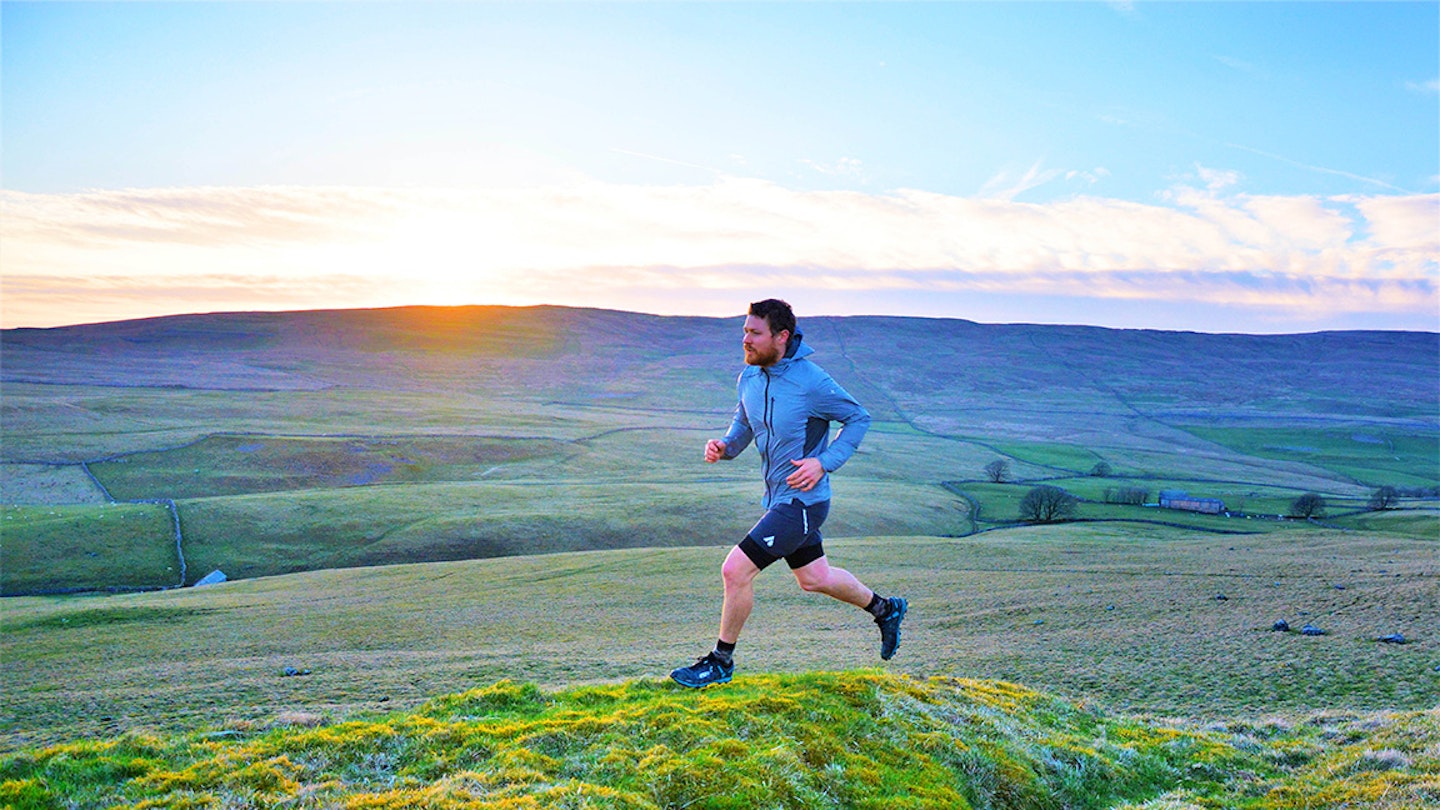
Don't forget that the best fell running shoes for you will be those suited to the environment you're running in, as well as your own preferences. Many shoes on this list would also make great winter trail running shoes as they prioritise foot protection and additional durable features.
While we’ve also suggested some options with added waterproofing. If you like the idea of tackling the wilds of the fells, but aren’t such a fan of getting your feet wet, then a waterproof trail running shoe with an extra injection of grip, while remaining lightweight might be the way to go.
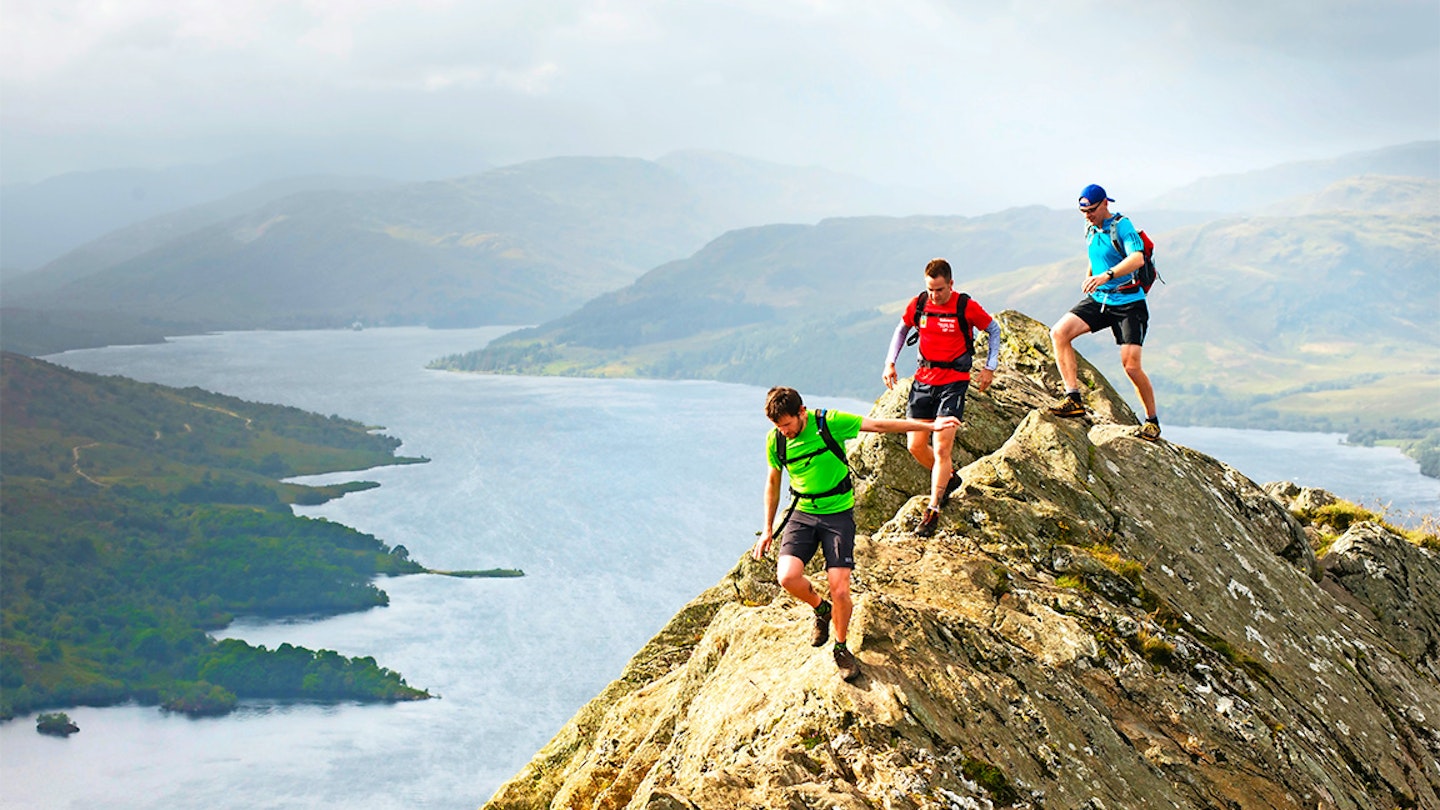
What to look for when buying fell running shoes
Fell running shoes are trail running shoes with specific features that prime them for particularly rough and extreme off-road running. If you're not familiar with shoe anatomy jargon, our trail running shoe buying guide will tell you everything you need to know. Here are the key features we'd recommend in a good fell running shoe:
Long lugs: Possibly the most important feature of a fell running shoes. Long lugs are needed to grip into the uneven and muddy ground, to provide good and stable traction. A minimum length of 5mm is recommended, and some fell running shoes can have lugs as long as 8mm.
Grippy outsole: Fell and mountain running shoes will have an outsole made form particularly grippy, or sticky, rubber. This is so that they can help to provide good grip across a range or surfaces, even when wet. In particular, a sticky outsole should be able to provide traction over wet rocks.
Drainage system: Fells are often water-logged and since they often don't have a particular path or trail on them, they can be wet and muddy too. Hence, it's key that a fell running shoe can quickly and efficiently drain away any water that does get inside the shoe. This will be via a breathable upper, or sometimes even through drainage holes in the outsole.
Waterproofing: If you prefer to avoid getting wet feet all together, then you'll need to opt for a pair of waterproof fell running shoes. Most will have a Gore-Tex lining on the upper to make them impregnable to water, just make sure they have a gaiter or a good seal on the top to avoid water getting inside and staying there!
Quick-tie laces: You're pretty much guaranteed to get wet shoes when fell running, so to make your life easier, look for shoes that have a quick lace system, also called lock lace, which just needs a simple pull on a drawstring to do up and push of a button to release. This will keep the weight of your shoe down, and avoid you'll having to deal with soggy laces after or during a run.
Lightweight: Since fell running involves a lot of running up and down hills, as well as navigating technical and uneven terrain, a lightweight and agile fell running shoe will help to keep the effort down, regulate temperature, and mean they're quick-drying after a run.
Protective: Some protective features will be appreciated when fell running, as you can easily bump into rocky sections, be surprised by roots, and big clumps of mud. Look for shoes with a protective toe bumper, extra durable rip-stop style upper, and a reliably solid outsole with rockshield.

Are trail and fell running shoes the same?
While fell running shoes are a type of trail running shoe, they do have distinct characteristics that set them aside from your everyday trail running shoes. As mentioned in our key features advice above, a fell running shoe should prioritise grip and agility above all else.
Since fell running can often mean running over rough and untouched off-road terrain, which will often be thick with mud or boggy with water, it's important that your fell running shoes has long enough lugs (spikes on the outsole) to dig into the ground and create traction at toe-off.
Without these, you'd be slipping all over the place and unable to run, not to mention at a much greater risk of injury from falling over.
Another reason why lugs and grip is even more important in a fell running shoe than a general trail running shoe is that fell running involves more uphill and downhill efforts, so you'll need that multi-directional traction to help propel you where you need to go.
As you might have guessed, you want your fell running shoes to be lightweight because you're working much harder on the fells to stay steady and find a good line across the uneven ground.
It's important that your shoes are light and breathable, with either a waterproof outer or a good drainage system to avoid them getting clogged up with mud and water. An agile pair of fell running shoes will equate to much less energy expenditure and a faster pace while running.
Can I fell run in hiking shoes?
If you were being chased by an angry dog, you could absolutely run in hiking shoes. However, walking and running are quite different, and the differences in walking and hiking shoes generally reflect this.
Hiking shoes often have a bigger drop to suit a walker’s stride, while running shoes have a lower drop to serve a running gait. Hiking shoes don’t tend to have the same level of cushioning as running shoes either, so it’s usually more comfortable to hike in a fell/trail running shoe than run in a hiking shoe.
That said, there are many shoes that are a bit of a crossover and could potentially be used for both – so it very much depends on the shoe.
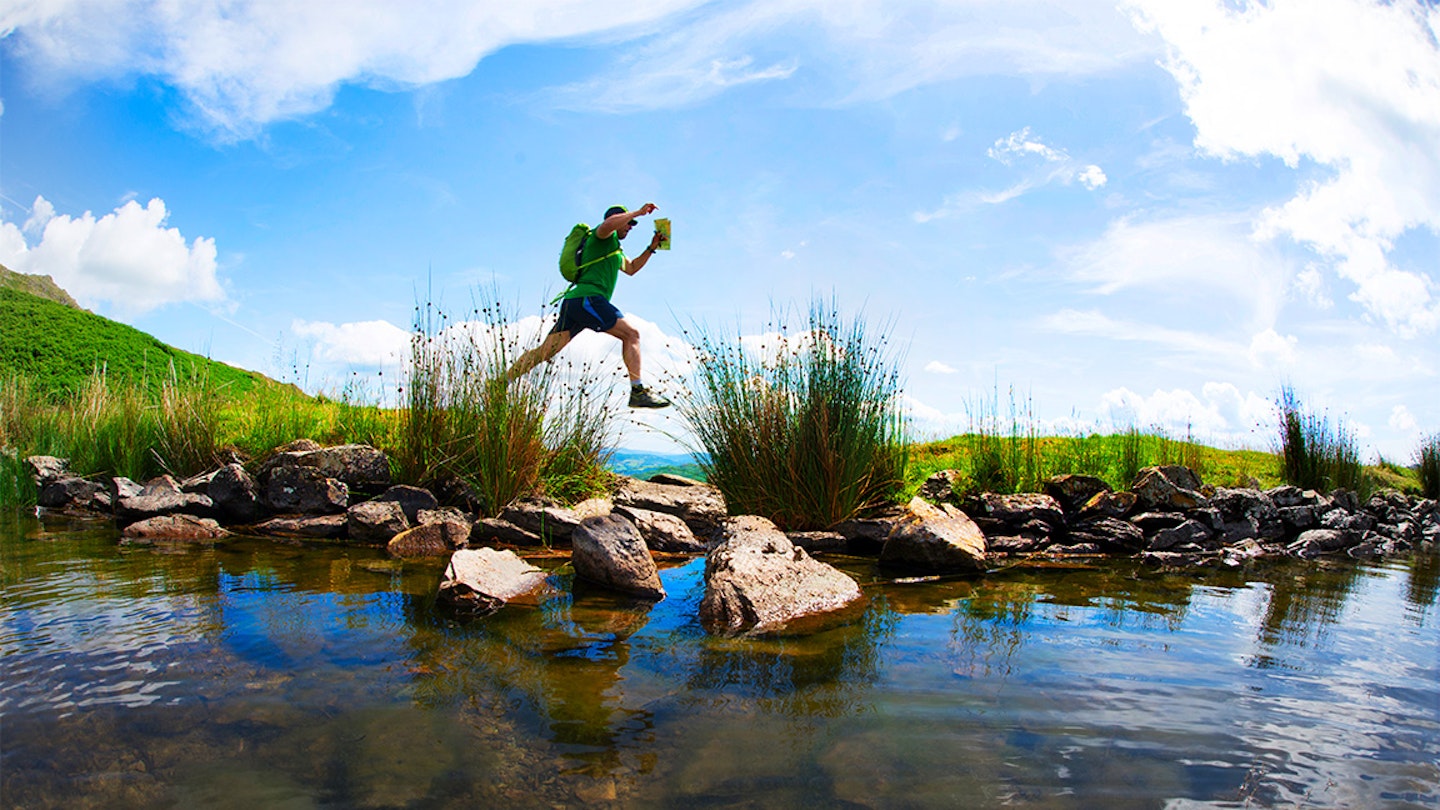
How long should fell running shoes last?
While a normal pair of trail running shoes can last anywhere between 500-800km total mileage before it'd recommended that you refresh them, fell running shoes may need to be replaced more often due to the simple fact that they will take much more of a beating.
Out on the fells, the terrain can be extremely muddy, wet, rocky and above all, unforgiving. Your chosen running shoes will get caked in mud and debris, along with sodden from boggy sections, unless you've chosen to don a pair of waterproof trail running shoes.
That being said, fell running shoes should be made of more durable stuff than your everyday trail running kicks. Look out of extra durable uppers, exaggerated toe bumpers, and thick rubber outsoles with lots of inner shoe structure as all of which to increase the shoe's longevity.
If you've been lucky and picked a high-quality fell running shoes like those in this list, then it could last as long as 800km. Just be sure to pay closer attention to your fell running shoes, because chances are they'll give up the ghost closer to up to 500km.
How should a fell running shoe fit?
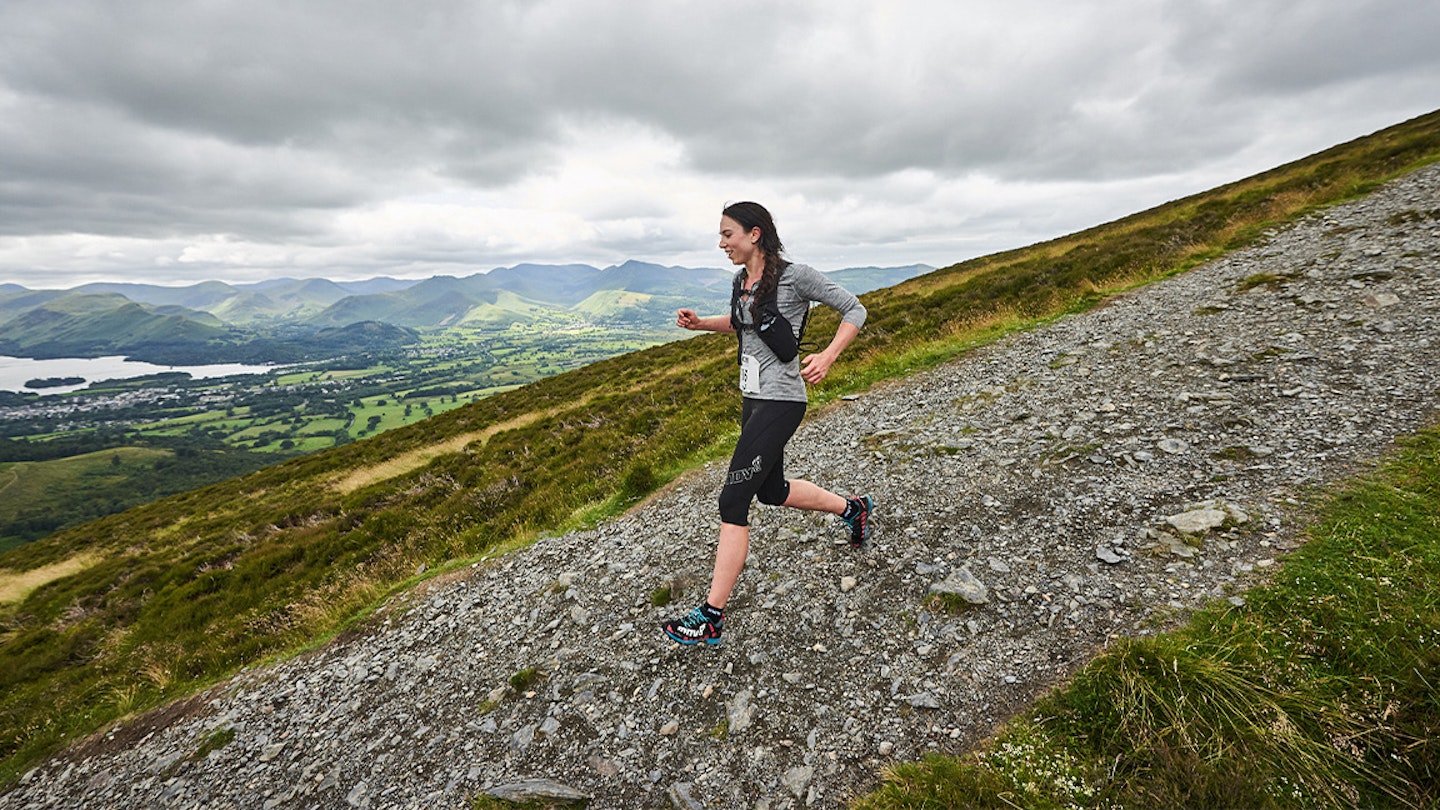
Fell running shoes tend to be closer fitting than your run of the mill trail running shoes, and certainly slimmer than an ultra trail running shoe. Fell running shoes generally tend to have a more moulded fit to your foot, while remaining flexible enough to expand with the foot and hug it snugly as you run.
A snug fit will help improve agility and to achieve a more streamlined stride. Since a fell running shoes tries to be as lightweight as possible, it won't have too much extra cushioning, an extra wide toe-box, or a multi-layer upper. It'll be as stripped down and functional as possible.
What drop is best for running shoes?
The drop of a running shoe refers to the height difference between the heel and the forefoot. Some shoes are zero drop, meaning they’re completely flat and as such, provide little arch support. A zero-drop shoe or a shoe of up to 3mm drop will suit those with flatter feet, or those who prefer to have a more ‘minimalist’ shoe geometry.
On the other end of the scale, some shoes will have a drop of up to 10-12mm. A larger drop like this will likely be seen in a shoe with additional structural support and cushioning, and this can benefit a runner with higher arches or in need of additional stability and support.
In the mid-range therefore is a drop of 3mm – 8mm, which can be seen in many trail running shoes. If you think you have pretty average arches and want a little but not too much support and structure in your shoe, then this level of drop will probably suit you best.
As with anything, it’s important you get to know your shoes and gait pattern in order to ascertain what set-up will work best for you. If you're not sure, we'd recommend you get a gait analysis done at your local running store, or ask a podiatrist if you often have issues with fit.
How to clean fell running shoes
Fell running shoes get a hard life. If you want to keep yours performing as well as they can for as long as possible, a little TLC is needed. Keep your shoe clean to maintain breathability, and remember that waterproof fabrics need reproofing every so often to maintain water repellency. Here are the products we'd recommend to help extend the life of your trail running shoes...
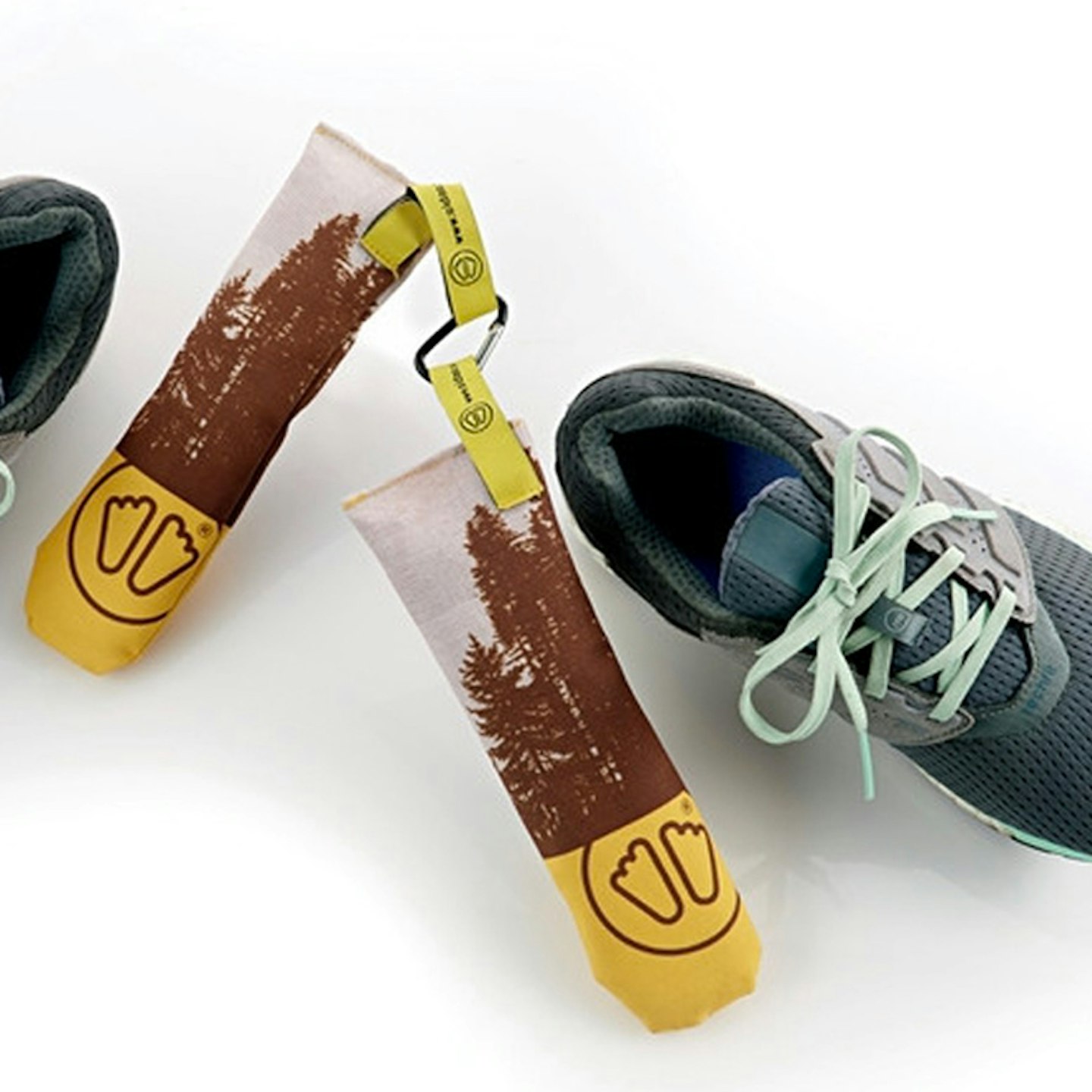 Sidas
Sidaswww.sidas.com
While the other products in this list will keep your shoes squeaky clean on the outside, these dryer bags will help soak up the moisture from your running shoes on the inside. Keeping them feeling fresh and free of that post-run 'pong'. We've never come across such a handy product to help refresh our kicks after wet runs. These sacks are stuffed with 100% cedar wood, which absorbs moisture out of the inside of a shoe four times quicker than air drying. They're also re-useable – simply hang them up to dry after use for six hours in between runs, then they're ready to go again!
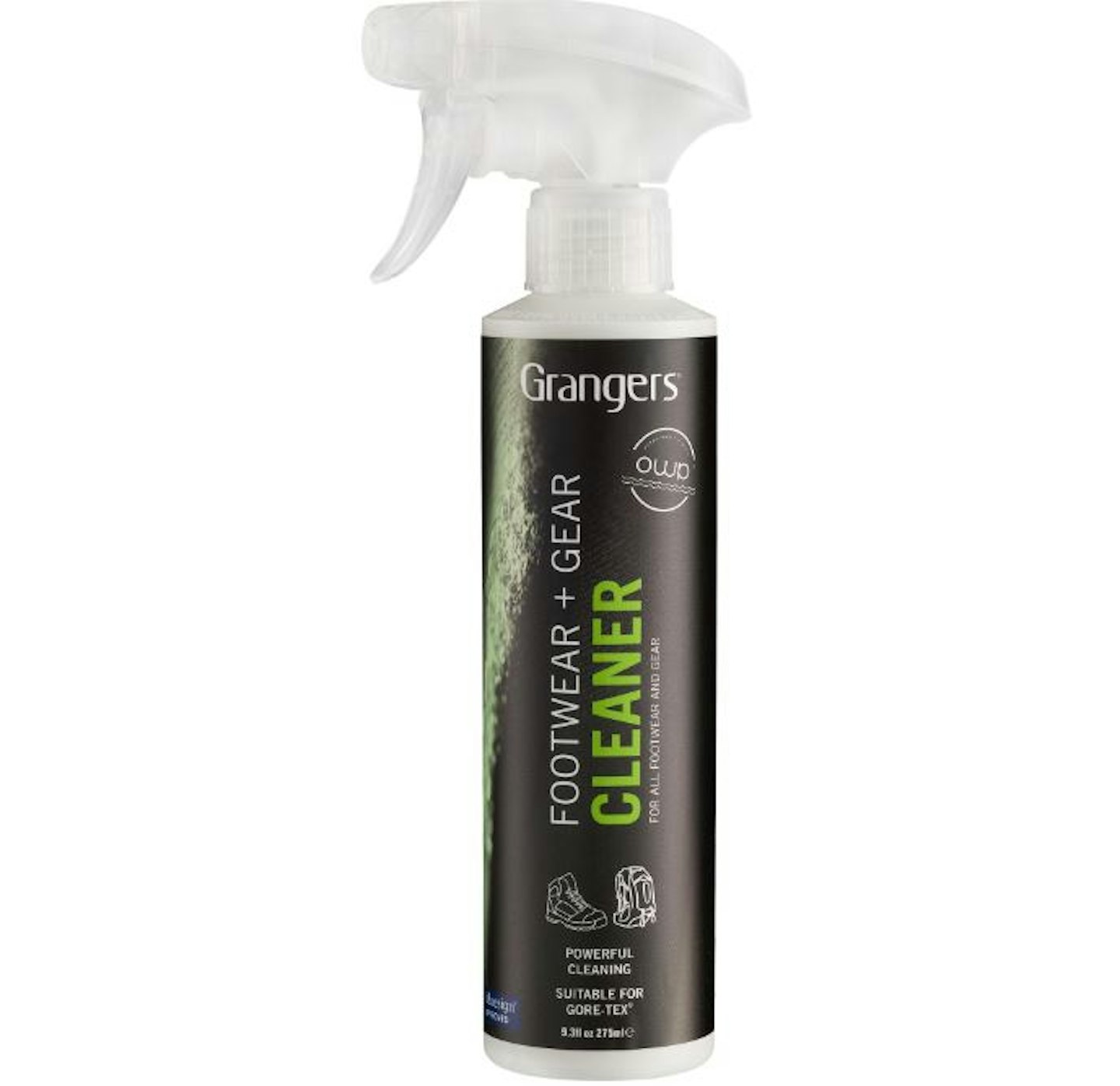 Amazon
AmazonExtend the lifetime of your running shoes by keeping them well looked after. This spray is a PFC-free, environmentally conscious spot cleaner (275ml), designed for footwear and outdoors gear. It's also Gore-Tex friendly, so won't denigrate the longevity of your waterproofing.
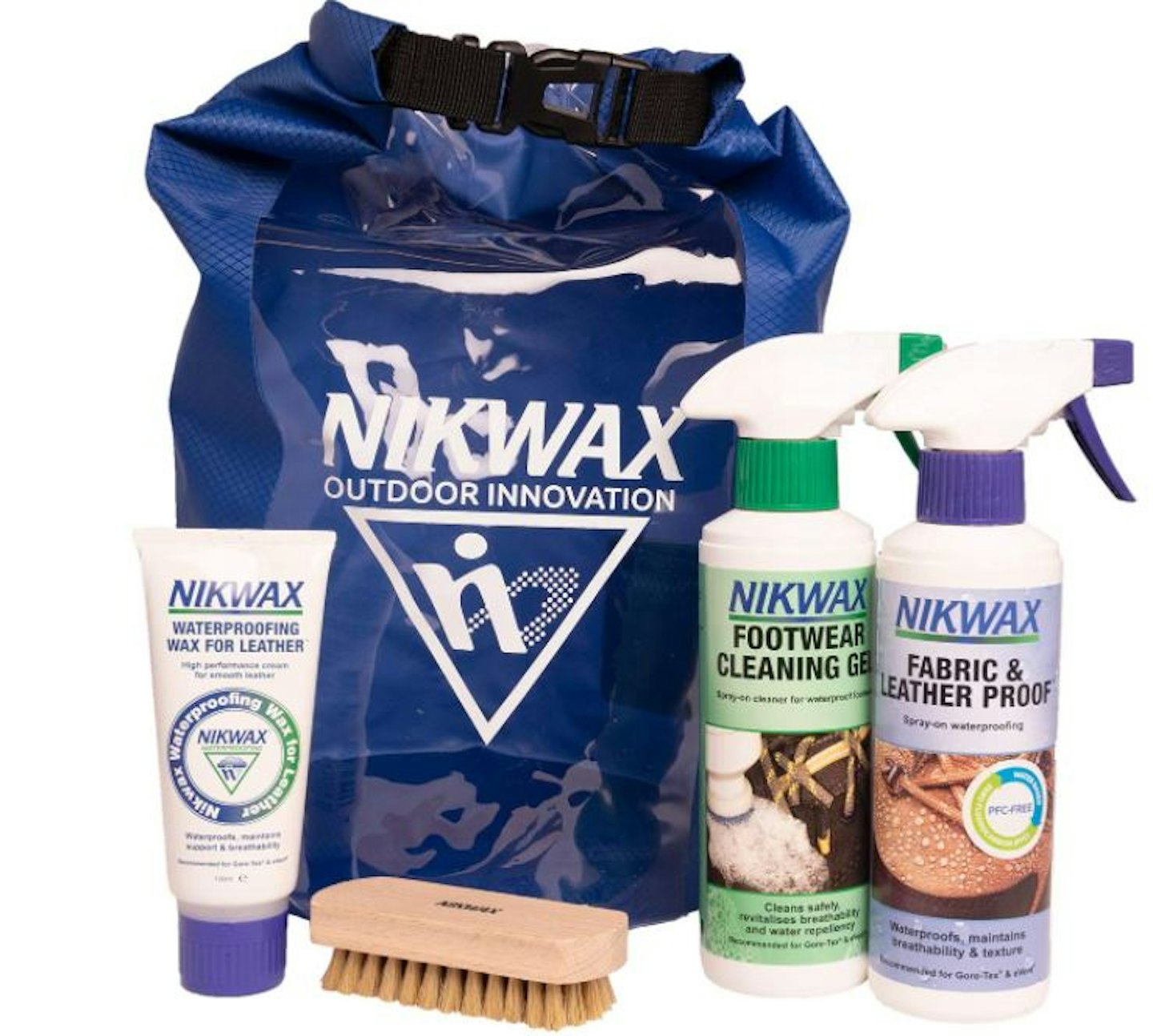 Amazon
AmazonThis Nikwax bundle is a footwear care kit for leather and fabric materials, complete with a brush and a dry bag. This kit earns high marks for its sustainability credentials, and the included dry bag proves invaluable during extended running trips and adventures.
Top image credit: Inov-8 and Scott Sports
About the author
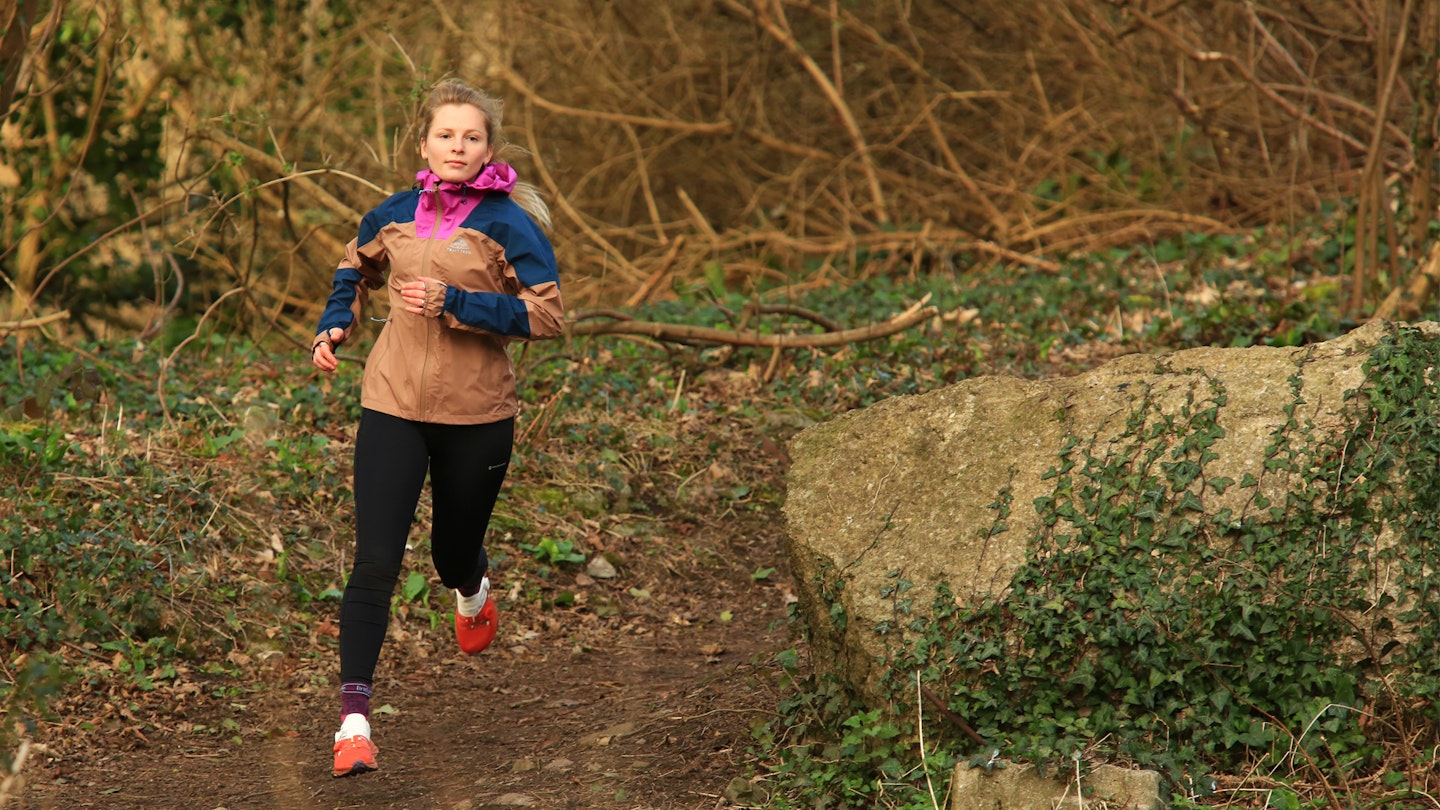
Kate Milsom a trail running gear tester and avid runner, who used to be a full-time member of the LFTO team but is now travelling the world and making us all jealous as she runs and explores tropical and faraway places. We're still making her test and review kit though!

